Just So
Saturday, October 31, 2009

This is just a picture of the Elephant’s Child going to pull bananas off a banana-tree after he had got his fine new long trunk. I don’t think it is a very nice picture; but I couldn’t make it any better, because elephants and bananas are hard to draw. The streaky things behind the Elephant’s Child mean squoggy marchy country somewhere in Africa. The Elephant’s Child made most of his mud-cakes out of the mud that he found there. I think it would look better if you painted the banana-tree green and the Elephant’s Child red.
Rudyard Kipling, Just So Stories – For Little Children Illustrated by the Author
On Thursday I wrote a blog that was based on my finding a quatrain by Fernando Pessoa in Andrea Camilleri’s, Salvo Montalbano novel, August Heat. I wanted to make sure I understood exactly what the author (Camilleri via his protagonist Montalbano) meant by a quatrain. I also wanted to know what the equivalent in Spanish was. I wasn’t too sure that cuarteto was the right word. So I looked it up in an on-line English Spanish dictionary. Read below:

I was struck by the example of a quatrain in the definition. It was a quatrain by Rudyard Kipling. I was wowed momentarily. I left it there, wrote my blog and went to bed.
This afternoon my daughter Ale called me from Lillooet. I was prepared for a lengthy (always interesting) meandering stream of consciousness. That was the case but she peppered her meanderings with praise on how my wife and I had brought her up and educated her. It seems she was transferring some of this knowledge to her second graders. I am unable to accommodate praise so I attempted to change the subject. But Ale kept on and mentioned the words what and why. Bells began to ring loudly in my head. While I was listening to her I racked my brain as to where I had read those two words and more. Finally I resorted to multi-tasking and I went to my Google bar’s History and looked up the websites I had opened yesterday. I found this. Suddenly Rudyard Kipling came back to my memory and I searched in in my Collected Verse of Rudyard Kipling (Toronto The Copp Clark Co., Limited – 1910). I purchased the book at my local Safeway’s book bin for $0.50 a few years back. I could not find the quatrain there. I Googled (while talking to Ale on the phone) and found this reference:
Poem by Rudyard Kipling
following the story "Elephant's Child" in "Just So Stories"

I told Ale about it and repeated the quatrain and where it came from. “Papi,” she told me, “My padrino Andrew (that's Ale, age 7 or 8 and Andrew Taylor in picture below) gave me Just So when I was little girl. You have it in your library bound in read leather.” I looked for it. I found it. I went to the Elephant’s Child and at the end, sure enough, was the quatrain and the rest of the poem:
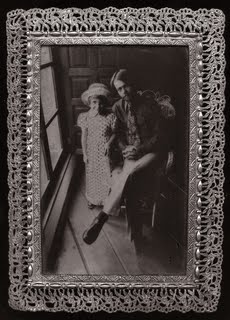
I keep six honest serving-men
(They taught me all I knew);
Their names are What and Why and When
And How and Where and Who.
I send them over land and sea,
I send them east and west;
But after they have worked for me,
I give them all a rest.
I let them rest from nine till five,
For I am busy then,
As well as breakfast, lunch, and tea,
For they are hungry men.
But different folk have different views;
I know a person small
She keeps ten million serving-men,
Who get no rest at all!
She sends em abroad on her own affairs,
From the second she opens her eyes
One million Hows, Two million Wheres,
And seven million Whys!
And would you believe that Ale initiated a discussion as to what Kipling meant by honest serving men. That was interesting, too!
Saxena's Prison
Friday, October 30, 2009
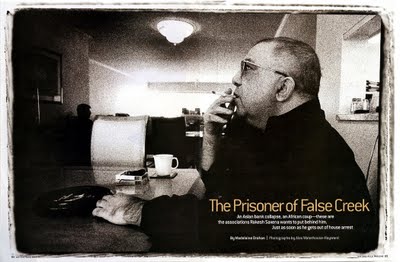
Of all the covers and magazine spreads I have had through the years one of my best is the one that appeared in the May 2001 Report on Business Magazine. The art director asked me to be present during Rakesh Saxena’s interview by writer Madelaine Drohan.
The setting was Saxena’s luxury “prison” condo in False Creek. He had persuaded the Canadian legal system to not send him to jail while his trial was in effect but keep him in the condo. Saxena would no only pay for the condo’s rent and all other expenses but the security to keep him firmly inside! (Only in Canada!) My guess is that Report on Business picked Drohan as she was quiet and unassuming so that Saxena might just open up to her. The cautioned me to also be low key. I decided (in an era preceding the immediate result on the back of a digital camera) not to take a large camera and a Polaroid back. I chose to take a venerable Pentax MX loaded with Ilford Delta 3200 ISO film. This meant I would not need lights and I would be able to shoot unencumbered. But there is one twist here that I never told the art director about. I chose to use a beautifully corrected 20mm wide angle. This meant that I was very close to Saxena when I took my pictures. I was in an in-your-face situation. I kept my mouth shut and he did not seem to mind.
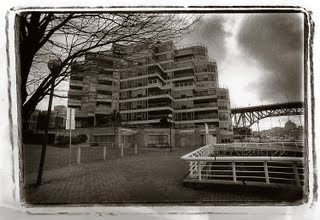
When I saw the magazine I was in joy on how well the art director had interpreted my photograph.
For a detailed account on Saxena’s case (he was finally extradited to Thailand yesterday) please read David Baines’ account here in today’s Vancouver Sun.
Addendum by Vancouver Sun Business Columnist David Baines
His photograph captures the man, and the menace. He was barely five foot six. You can see how stubby his fingers are, and how his head and his neck and body - rather than being disparate parts - are more of a continuum. His eyes bulged and circled, like a character from Disney’s Monsters Inc. He sucked on those cigarettes constantly, no doubt a factor years later when he had a stroke and suffered partial paralysis in his left arm. He hosted a steady stream of visitors and seemed to treat each one with a kind of cordial equanimity, but this, too, was a ruse. He was always sizing people up, assessing what opportunity, or nuisance, they presented. He was brilliant the way he could play people. For 13 years, he tied us in knots, thwarting the extradition system while working his sleazy scams from his gilded cages in False Creek, and then Richmond. For a while, I thought he was going to outlast the Canadian justice system. So did he. We were both wrong. He was one of a kind. At least, I hope he is.
That Pessoa Blonde
Thursday, October 29, 2009

This morning I finished August Heat, the tenth in the series of 16 novels by Andrea Camilleri featuring Inspector Salvo Montalbano. Ths means I must now wait for Andrea Camilleri’s translator, Stephen Sartarelli to translate the 6 remaining Inspector Salvo Montalbano novels.
I made a decision today that I am going to read at least one work by Portuguese poet Fernando Pessoa ( 1888 – 1935) because after having read so many novels by José Saramago including The Year of the Death of Ricardo Reis (Ricardo Reis was one of the many heteronyms for Pessoa) I have realized that no Pessoa in my head must be equal to a big vacancy of important content. What finally pushed me to make the decision is a Pessoa quatrain that sings in Salvo Montalbano’s head in August Heat:
And as the girl approached and her features, eyes, and hair colour became more and more distinct, the inspector slowly stood up, feeling himself happily drowning in a sort of blissful nothingness.
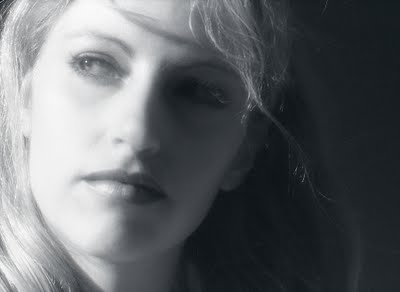
Head of pale gold
With eyes of sky blue,
Who gave you the power
To make me no longer myself?
The Gun
Wednesday, October 28, 2009
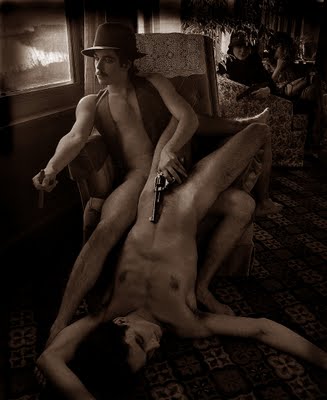
When I first came to Canada in 1975 wanting to become a professional photographer I decided that there were some things I would never do. I vowed to never shoot a wedding, babies or pornography.
I can recall shooting Susan Musgrave getting married to her bank robber beau at a maximum security prison in Agassiz and the first wedding of DOA's singer/guitarist Joey Shithead. I have taken picture of both of my granddaughters after they were born and as they grew. I must admit that I changed my mind about pornography and I attempted to shoot some. Every time an inner "good taste" valve took over and I was unable to go through it or to get results that bordered on pornography. I thought I was being daring in taking individual portraits in sequence (just the face) of two different women going through self-induced orgasm. But I was astounded by several irate complaints from women friends who were annoyed, almost insulted, that I had not asked them to pose.
But here you will find one of the strongest photographs I have ever taken. I took only two versions of it. In one the young man with the gun is looking at the camera and the other is the version you see here. A prominent journalist friend of mine owned the Webley. I was told to be careful when I transported it to my destination, a parked railway parlour car on the CP Railyard. If I were to be stopped by a policeman I was not to divulge who the owner was at it was unlicensed. Fortunately nothing like that happened.
A Postcard To That Renaissance Man
Tuesday, October 27, 2009

WRITE YOU ARE: In the midst of today's electronic-messaging blizzard, including his own www.alexwaterhousehayward.com website, photographer Alex Waterhouse-Hayward has adopted a medium as old as the Pony Express. He's sending hand-written promotional postcards via Canada Post to corporate, institutional, political and cultural biggies he's portrayed for a generation. Showing the photographer's work on one side, the postcards were produced by George Kallas's Metropolitan Fine Printers firm, which routinely wins international awards.
Do postcards work? In his Confessions Of An Advertising Man memoir, David Ogilvy recalled being the greenhorn in a 1930s British ad agency and pestering to handle a campaign. Others scoffed when he got a hotel account worth 100 pounds. Ogilvy spent the sum -- paltry even then -- on stamps and postcards, which he filled out. The hotel filled every room, and Ogilvy went on to found the Ogilvy, Benson and Mather agency and become an ad-biz legend.
Malcolm Parry, Vancouver Sun, October 22, 2009
A week and a half ago I sent Vancouver Sun columnist Malcolm Parry a postcard. He did not acknowledge receipt. He did one better. He wrote about it in his October 22 business column and even included one of my self portraits. It that wasn't enough the Wednesday Vancouver Sun previewed it on the front of the business page and included that self portrait.
With the struggle that any photographer based in Vancouver has to go through now that the-best-price-is-free mentality of the web this was was like an electrical shock on my dying body's chest. Who knows it just might help. But then Mac (as those of us from his earlier incarnation (read his bio below to find out about his several incarnations) call him has always been there for me. He pretty well gave me my first photo job in Vancouver and even saw in me a writer of sorts. If I say that I have a godfather in Vancouver it would have to be Mac.
Malcolm Parry was born and educated in England, where he studied civil engineering and worked as a part time musician playing the saxophone.
In Canada he worked as a commercial and industrial photographer and later as the advertising and public relations manager of a telecommunications manufacturing division of New York based General Telephone and Electronics International, now the Verizon Corporation. He also freelanced extensively as a writer and photographer for regional and national newspapers and periodicals in Canada.
In 1970 he was the founding editor and later publisher of the Vancouver-based buisness periodical B.C. Affairs and founding editor/publisher of its spinoff periodical B.C. Industry Reports. In 1974 he was founding editor and later publisher of the city monthly periodical Vancouver Magazine. He remained editor for two terms totalling 15 years, during which time he, the magazine and its contributors won many regional and national and some international awards.
During that period he was founding executive editor of Edmonton and Calgary Magazines and of the B.C. business periodical Equity. For briefer periods he was editor of Western Living magazine, which publishes editions in B.C. Alberta Saskatchewan and Manitoba, and was also editor of a Vancouver city affairs publication titled V.
He was founding editor of the Toronto based business magazine Vista, where he won a national award for art direction.
A Vancouver Sun columnist since 1991, he has written about all manner of social, cultural,entertainment, business, education and political doings and has photographed for publication some 1200 individuals.

In early spring (note the white camellias) of 1992 I photographed the former fashion columnist for the Vancouver Province, Kay Alsop. Everybody at the time was commenting on what was then the hottest topic in town. This was Malcolm Parry's gossip colum Town Talk. I asked Alsop what she thought of Parry. She said, "Mac is going to turn off the lights at the Sun."

Coming home with my friend John Lekich from an evening with Stephen Sondheim at the Vogue (expertly and quietly moderated by the former theatre reviewer of the Province, Jerry Wasserman) I told Lekich the Kay Alsop story. John's comment was, "She just might be prophetic." I might believe that. But I also believe Mac will find something else to occupy his time. He has plenty of talents to choose from. As a photographer he could certainly give me a run for my money. The picture here of me he took in his backyard around 1990.
¡Gracias padrino!
English Elegance & Margaret Merrill Say Goodbye
Monday, October 26, 2009
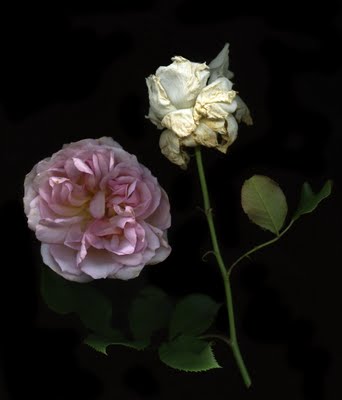
My grandmother taught me a lot, not only because she had been a teacher at Assumption College in Manila in the 20s and 30s but because she was ahead of her time in believing that nobody was ever too young to learn. I remember the first time she mentioned, “Se despidieron a la francesa.” “They said goodbye, French style.” Some guests at a party my grandmother had given had suddenly disappeared. I was 8 or 9 and a bit curious so I asked her what this meant.
She told me that during the Napoleonic wars Napoleon had made his older brother Joseph, king of Spain (Joseph I) in 1806. In 1813 Wellington and his English and Portuguese forces defeated the French army at Vitoria and Joseph was gone after trying to abdicate. My grandmother explained, “The French left so quickly they forgot to say goodbye. And even today the Spanish still use the expression when people are rude in their farewells.”
What is most interesting is that Joseph went to live in the United States. He first settled in New York City and Philadelphia but finally settled in Bordentown, New Jersey before returning to Europe in the early 20s.
To this day in Spain and in my Buenos Aires anybody who is a bit of a fop or a dandy is called un afrancesado or Frenchified.
The two roses here I scanned today. The pink one is Rosa ‘English Elegance’ most elegant even at this later date. The white one is Margaret Merril a bit ruffled and roughed up by today’s wind. The former is a David Austin English Rose and the second is a Harkness floribunda. It is also bred in England.
My Spanish grandmother (who was an Anglophile) would have gleefully pointed out that these two roses indeed have good manners as they have said goodbye before leaving us, as winter (or what seems like winter) settled in today.
That Profane Urbanist's Home
Sunday, October 25, 2009
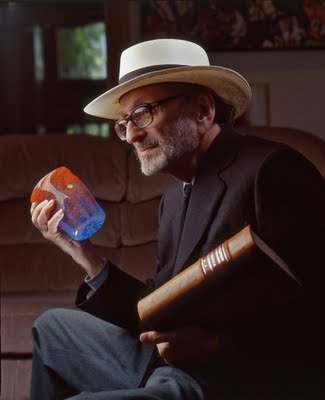
My grandmother who lived in Valencia, Sevilla, Madrid, Manila, the Bronx, Buenos Aires, Mexico City and Veracruz spoke of all those places with delight but I never had a sense that she felt she belonged to any of them. She had moved too many times. “Her two “camphor babies” were her home,” my mother used to say. These were intricately carved chests that traveled with her since the early 30s. The two chests are in my living room and they are a constant reminder of the only grandmother I ever knew and loved. Inside those chests are a collection of Spanish fans, shawls, my Mappin & Web birth spoon and other mementos of the life of my grandmother, grandfather, my mother and me.
In 1957, that first year that I was at St. Edward’s High School I was not quite 16 and I had never left home. Suddenly I was in Austin, Texas in a large neo-Gothic dormitory and our dorm prefect, Brother Vincent De Paul CSC would throw a silver dollar on our bed. If the dollar did not bounce he would lift the mattress and throw it on the floor. We went to the bathroom in a large communal one and privacy was only present at night when we lay in our beds. Our thoughts were then our own.
A piece of home was my locked metal chest, a cheap one my mother had purchased at an army surplus store on South Congress Avenue just one side, north, of the Congress Avenue Bridge. Nobody could open my chest and what was inside I shared with nobody. It was home. It wasn’t a camphor baby, but it was home, nonetheless.
Like my grandmother I have been around. Even though I lived in Vancouver since 1975 it often feels like a city I am visiting and that I am a tourist.
I have come to understand the significance of the fact that both my granddaughters, Rebecca, 12, and Lauren, 7, were born in Vancouver. They have not moved from it. This is their home. This is their city. And best of all they belong here. I am not sure I can say that about myself and my relation to this city.
Today Rebecca and I attended a celebratory memorial to Abraham Rogatnick held at the Great Hall of the Vancouver Law Courts. I wanted her to accompany me not only because Abraham Rogatnick, Rebecca and I had attended many baroque concerts (particularly those Friday evenings at St. James Anglican complete with Oreos, tea and coffee) and spent time in my summer garden drinking iced tea and enjoying the June roses. I wanted Rebecca to be with me because she would meet many of the people who made Vancouver the city it is today.
Being part of a city is to feel urbanity for it. Abraham Rogatnick, the architect, brought together, under one roof today many urbanists, artists, politicians, composers, jewelers, actors, all that much more urbane for having met that ultimately urbane man that he was in spite of his often off-colour profanity when something got his goat.
And so Rebecca chatted with Cornelia Oberlander and Edith Eglauer, and Tom Cone. There was Gavin Walker, Dorothy Barkley, Geoff Massey, Sam Sullivan and many more. She heard Peter Busby talk about Rogatnick the teacher, perhaps feeling just a bit guilty about her rejecting his little lecture on art deco architecture in Mayor Sam Sullivan’s office one afternoon a year ago.
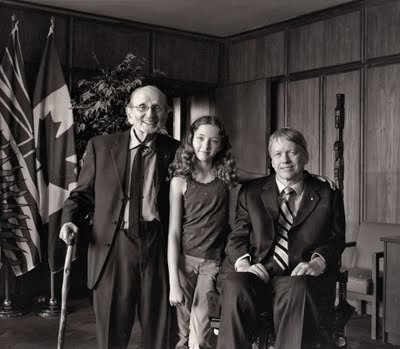
I explained to Rebecca how the man she had met and chatted with many times, Arthur Erickson had built Robson Square, the law courts and adapted the old court house to be our Vancouver Art Gallery. I explained how Cornelia Oberlander had done the landscape architecture. I didn't want to transfer my superstitious beliefs to her so I didn't tell her that I felt the presence of those two friends and ghosts, Erickson and Rogatnick who were hovering about as we sampled our éclairs. A confirmed atheist, Abraham Rogatnick, would have said to me, "Don't fill Rebecca with all that crap."
If Rebecca and Lauren’s luck persists they will never have to call a chest, be it of precious oriental wood or cheap tin, home. Home, for them, will be Vancouver, a city, all the better for having been a home for Abraham Rogatnick and his companion Alvin Balkind since 1954.
Saturday, October 24, 2009
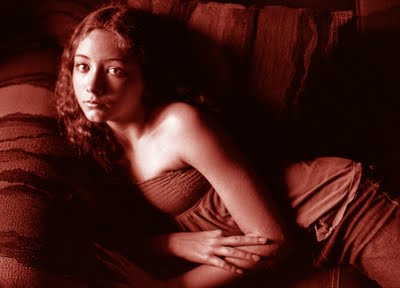
It was at St. Edward’s High School in my Junior year that Brother Dunstan taught me about catharsis. He told us that the ancient Greeks went to see tragedies knowing exactly what the resolution would be yet they would not be sure of the details. At some point during the play, or right after, the audience (and the actors, too) would experience a a satisfying purging of their emotions which Aristotle named a catharsis. This is why plays are so useful in explaining to us the intricacies of our emotions and how they play in our life.
I sat with Rebecca tonight watching the Playhouse Theatre Company Production of The Miracle Worker, beautifully directed, just right by Meg Roe. From our second row seats we were able to discern every emotion, every tick, every gesture of the actors including the exceptional young girl, Margot Berner who plays Helen Keller.
At the point where Helen Keller makes that important connection between the sign language spelling of water with the water itself (and is finally able to think through the discovery and use of language, I could feel tears running down. It was Brother Dunstan’s catharsis.
In the car Rebecca said (showing me a Kleenex with black smudge marks), “I should get my money back on this Maybelline makeup, it runs.” “Did you experience a catharsis?” (I had explained to Rebecca the concept.) I asked her. “It’s none of your business,” she answered. I drove home with a smile thinking about Brother Dunstan and how lucky I was to have had him for a teacher and how lucky to have Rebecca as my granddaughter.
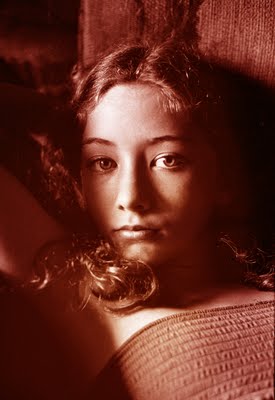
I took the pictures of Rebecca here today after lunch using a hefty Nikon F-3 loaded with Kodak Tri-X. The lens was a 50mm f-1.4 and my exposure was f-2.8 at 1/60 second. Holding that solid F-3 and listening to the "I-mean-business" motor drive was a catharsis in itself.

It was at St. Edward’s High School in my Junior year that Brother Dunstan taught me about catharsis. He told us that the ancient Greeks went to see tragedies knowing exactly what the resolution would be yet they would not be sure of the details. At some point during the play, or right after, the audience (and the actors, too) would experience a a satisfying purging of their emotions which Aristotle named a catharsis. This is why plays are so useful in explaining to us the intricacies of our emotions and how they play in our life.
I sat with Rebecca tonight watching the Playhouse Theatre Company Production of The Miracle Worker, beautifully directed, just right by Meg Roe. From our second row seats we were able to discern every emotion, every tick, every gesture of the actors including the exceptional young girl, Margot Berner who plays Helen Keller.
At the point where Helen Keller makes that important connection between the sign language spelling of water with the water itself (and is finally able to think through the discovery and use of language, I could feel tears running down. It was Brother Dunstan’s catharsis.
In the car Rebecca said (showing me a Kleenex with black smudge marks), “I should get my money back on this Maybelline makeup, it runs.” “Did you experience a catharsis?” (I had explained to Rebecca the concept.) I asked her. “It’s none of your business,” she answered. I drove home with a smile thinking about Brother Dunstan and how lucky I was to have had him for a teacher and how lucky to have Rebecca as my granddaughter.

I took the pictures of Rebecca here today after lunch using a hefty Nikon F-3 loaded with Kodak Tri-X. The lens was a 50mm f-1.4 and my exposure was f-2.8 at 1/60 second. Holding that solid F-3 and listening to the "I-mean-business" motor drive was a catharsis in itself.
Friday, October 23, 2009
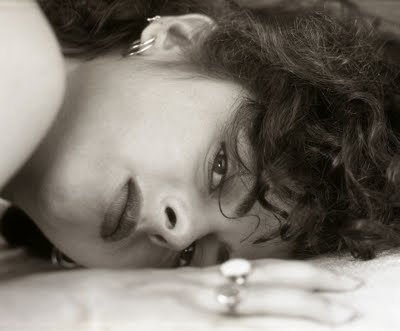
Just a couple of days ago I sold a photograph of Robertson Davies to a Barcelona publisher. I have been dealing with with a M. Àngels whom I suspect is a woman called María de los Ángeles. She refuses to reply to my Spanish and sends me letters in French. But she did indicate in English, “We are interested about the attached image. This is the mosaic of faces.” The picture in question is a scanned contact sheet. She must be young enough to have not concept (and this is most understandable) as to how we photographers used to (and some of us still do) make contact sheets in the darkroom. I have become a tad lazy about making contact sheets in the darkroom since I can scan the negatives in a sleeve and get just about the same thing without mixing any chemicals. I have to admit it is convenient.

It has all made me think how the language of photography has changed and the hidden messages the language changes convey. A friend of mine from Mexico used to say, “I am going to make a photograph.” I thought it a bit too much in the same way I prefer the use of the word photograph to the slightly more pretentious image. I like to say I take photographs or I take pictures. The modern term now is to capture a photograph (and more often) to capture an image.

Because that captured image does not remain in the camera for long as modern photographers chimp (to look at the image in the back of the camera right after taking it) they are losing (to lose is a loss only when you realize what you are missing) the concept, that wonderful concept, of the latent image. This is about an image that is there even when you cannot see it. In the 19th century the term used was to develop or develop out the latent image. That perceived magic which is magnified when one sees a b+w print’s image emerge in a developer bath in the subdued reddish light of a darkroom an experience that is forgotten (if you once printed) or it is an experience never had if you never printed. As my students look at each other’s little screens I see the benefits. They are instant benefits.
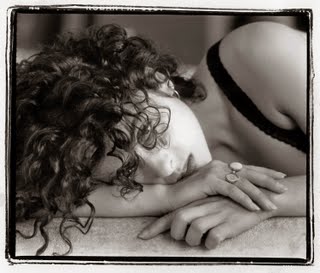
When one begins photography, be it digital or the other there is an important breakthrough that some photographers achieve and some that never realize of its possibility. The beginning photographer (I was one) relished going into the darkroom to print a negative or negatives. I would spend hours deciding on the crop. Should I remove this or that part of the negative? I may have spent a lot of money on sheets of photographic paper doing this. Then one day I decided I was going to crop in the camera and print the whole negative. What helped me in this is that I would decide that a picture could be a vertical and a horizontal and I would shoot both of them. This meant I never had to convert a horizontal to vertical by cropping it.

Photographers who printed their own negatives had a way of conveying that they printed 100% of the image of a negative. The method was to file (a metal file) the edges of the negative carrier. The edge would go a bit beyond the edge of the film negative and the roughness of the filing made the edge/border of the printed photograph a personal signature. No two negative holders could be identical. In the best of those past worlds the filed-edge border meant the photographer had printed the photograph.
But as soon as photography was digitized that border could be copied and inserted around any picture, be it cropped or not. For a while this happened until the memory of what the filed edge represented was lost. These Photoshop filed-edge-look borders are called crazy borders now. It is no different than not knowing what that crank that was inserted in 20s cars was supposed to be for.
So when you see my photographs here with that "crazy" border it means that I have real darkroom prints in my files or I have recently printed some. If the pictures do not have the border it means that I have scanned the negative.
The pictures here are of Susan Fiedler. I wrote about her before here and here.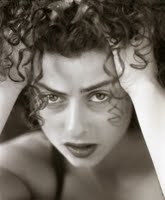
I think I have to look for someone like Susan to inspire me to take some new photographs. Meanwhile I will not forget what do to with that crank if the motor does not start.
When Charlie speaks of Lester
You know someone great has gone
The sweetest swinging music man
Had a Porkie Pig hat on.
Joni Mitchell
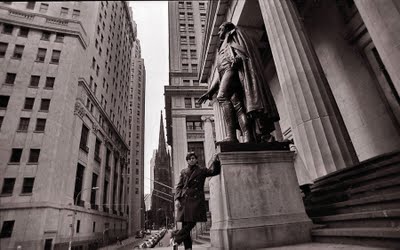
The saxophone
carries 18 to 21 brass keys,
and as many keys of harmony
as two and a half octaves can contain.
Press these keys, people dance
and dream of children
and the means to keep them alive.
From Prez - Homage to Lester Young by Jamie Reid
Gavin Walker told me today that just about every third blog has a picture of Rebecca or I mention her. The fact is that from the very beginning, some almost four years ago, I realized that my blog was going to be about self-discovery and that it was going to be a self-discovery based upon my attempt to get to know and understand my granddaughter Rebecca. Just about anything I do, on any given day, I can relate to her. I sense this even when I talk with Rosemary. We are re-living our youth by experiencing the excitement of one who is young and full of an interest in undiscovered things.

If I play a CD that Rebecca has not ever heard in the living room on Saturdays or in the car, she will invariably enquire. For as long as she keeps enquiring I will look for CDs that she will ask about that may have an interesting story.

So it was last Saturday that I put Joini Mitchel’s homage to Charles Mingus, Joni Mitchell- Mingus, who was in Cuernavaca, Mexico dying (he died on January 5, 1979). The CD starts with a strange Happy Birthday and I then is followed by one of the most beautiful jazz tunes ever composed, Mingus’s Goodbye Pork Pie Hat. In the CD, Mitchell composed lyrics for the song and sings it. Rebecca said nothing. Later in the car I played the definitive version of it from Mingus’s 1959 album Charles Mingus/ Mingus Ah Um. Rebecca was all ears. There is a remarkable tenor saxophone solo by John Handy III, where he seems to play more than one note at the time. I would have called it harmonics but Gavin Walker explained that Handy had played trumpet in high school and he had good control of what he could do with his mouth. The technique is called flutter-tonguing.
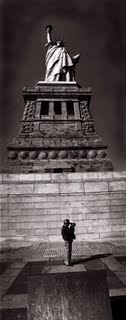
I found out a few days after Saturday that Rebecca had told Rosemary that she really did not like Joni Mitchel’s Goodbye Pork Pie Hat and preferred the Mingus/Handy version.
This Sunday Rebecca and I will be attending the Abraham Rogatnick Memorial at the Law Courts and Gavin Walker will be playing an alto saxophone solo of Sunrise, Sunset from Fiddler on the Roof. “I look forward to meeting up with Rebecca,” he told me.” And then he added, “I will be sure to mention to her that I approve of her taste for music.”
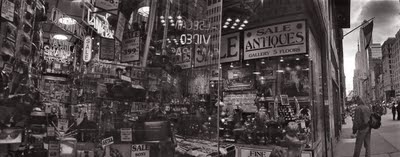
I have no photographs of Mingus (whom Rosemary and I saw perform so many years ago at Oil Can Harry’s on Alberni and Thurlow) nor of anybody wearing a pork pie hat. Gavin Walker told me that Mingus wrote the song in homage to saxophonist Lester Young who had died a couple of months before. Lester Young had a fondness for pork pie hats.
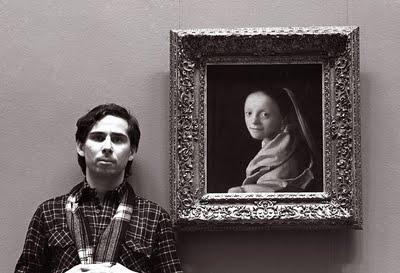
I had to find an excuse to write about this and with no pictures at hand I remember that I told Rebecca last week that the sound of Goodbye Pork Pie Hat is the sound of New York on a cold and melancholic rainy evening. It is the sound of a city going to sleep. It is the sound of a New York that I have visited twice. It is a sad sound for me. I will someday correct that feeling and make it a happy occasion by discovering New York again in the company of Rebecca.

Just a couple of days ago I sold a photograph of Robertson Davies to a Barcelona publisher. I have been dealing with with a M. Àngels whom I suspect is a woman called María de los Ángeles. She refuses to reply to my Spanish and sends me letters in French. But she did indicate in English, “We are interested about the attached image. This is the mosaic of faces.” The picture in question is a scanned contact sheet. She must be young enough to have not concept (and this is most understandable) as to how we photographers used to (and some of us still do) make contact sheets in the darkroom. I have become a tad lazy about making contact sheets in the darkroom since I can scan the negatives in a sleeve and get just about the same thing without mixing any chemicals. I have to admit it is convenient.

It has all made me think how the language of photography has changed and the hidden messages the language changes convey. A friend of mine from Mexico used to say, “I am going to make a photograph.” I thought it a bit too much in the same way I prefer the use of the word photograph to the slightly more pretentious image. I like to say I take photographs or I take pictures. The modern term now is to capture a photograph (and more often) to capture an image.

Because that captured image does not remain in the camera for long as modern photographers chimp (to look at the image in the back of the camera right after taking it) they are losing (to lose is a loss only when you realize what you are missing) the concept, that wonderful concept, of the latent image. This is about an image that is there even when you cannot see it. In the 19th century the term used was to develop or develop out the latent image. That perceived magic which is magnified when one sees a b+w print’s image emerge in a developer bath in the subdued reddish light of a darkroom an experience that is forgotten (if you once printed) or it is an experience never had if you never printed. As my students look at each other’s little screens I see the benefits. They are instant benefits.

When one begins photography, be it digital or the other there is an important breakthrough that some photographers achieve and some that never realize of its possibility. The beginning photographer (I was one) relished going into the darkroom to print a negative or negatives. I would spend hours deciding on the crop. Should I remove this or that part of the negative? I may have spent a lot of money on sheets of photographic paper doing this. Then one day I decided I was going to crop in the camera and print the whole negative. What helped me in this is that I would decide that a picture could be a vertical and a horizontal and I would shoot both of them. This meant I never had to convert a horizontal to vertical by cropping it.

Photographers who printed their own negatives had a way of conveying that they printed 100% of the image of a negative. The method was to file (a metal file) the edges of the negative carrier. The edge would go a bit beyond the edge of the film negative and the roughness of the filing made the edge/border of the printed photograph a personal signature. No two negative holders could be identical. In the best of those past worlds the filed-edge border meant the photographer had printed the photograph.
But as soon as photography was digitized that border could be copied and inserted around any picture, be it cropped or not. For a while this happened until the memory of what the filed edge represented was lost. These Photoshop filed-edge-look borders are called crazy borders now. It is no different than not knowing what that crank that was inserted in 20s cars was supposed to be for.
So when you see my photographs here with that "crazy" border it means that I have real darkroom prints in my files or I have recently printed some. If the pictures do not have the border it means that I have scanned the negative.
The pictures here are of Susan Fiedler. I wrote about her before here and here.

I think I have to look for someone like Susan to inspire me to take some new photographs. Meanwhile I will not forget what do to with that crank if the motor does not start.
Tongue Fluttering, A Pork Pie Hat & A Handy New York
Thursday, October 22, 2009
When Charlie speaks of Lester
You know someone great has gone
The sweetest swinging music man
Had a Porkie Pig hat on.
Joni Mitchell

The saxophone
carries 18 to 21 brass keys,
and as many keys of harmony
as two and a half octaves can contain.
Press these keys, people dance
and dream of children
and the means to keep them alive.
From Prez - Homage to Lester Young by Jamie Reid
Gavin Walker told me today that just about every third blog has a picture of Rebecca or I mention her. The fact is that from the very beginning, some almost four years ago, I realized that my blog was going to be about self-discovery and that it was going to be a self-discovery based upon my attempt to get to know and understand my granddaughter Rebecca. Just about anything I do, on any given day, I can relate to her. I sense this even when I talk with Rosemary. We are re-living our youth by experiencing the excitement of one who is young and full of an interest in undiscovered things.

If I play a CD that Rebecca has not ever heard in the living room on Saturdays or in the car, she will invariably enquire. For as long as she keeps enquiring I will look for CDs that she will ask about that may have an interesting story.

So it was last Saturday that I put Joini Mitchel’s homage to Charles Mingus, Joni Mitchell- Mingus, who was in Cuernavaca, Mexico dying (he died on January 5, 1979). The CD starts with a strange Happy Birthday and I then is followed by one of the most beautiful jazz tunes ever composed, Mingus’s Goodbye Pork Pie Hat. In the CD, Mitchell composed lyrics for the song and sings it. Rebecca said nothing. Later in the car I played the definitive version of it from Mingus’s 1959 album Charles Mingus/ Mingus Ah Um. Rebecca was all ears. There is a remarkable tenor saxophone solo by John Handy III, where he seems to play more than one note at the time. I would have called it harmonics but Gavin Walker explained that Handy had played trumpet in high school and he had good control of what he could do with his mouth. The technique is called flutter-tonguing.

I found out a few days after Saturday that Rebecca had told Rosemary that she really did not like Joni Mitchel’s Goodbye Pork Pie Hat and preferred the Mingus/Handy version.
This Sunday Rebecca and I will be attending the Abraham Rogatnick Memorial at the Law Courts and Gavin Walker will be playing an alto saxophone solo of Sunrise, Sunset from Fiddler on the Roof. “I look forward to meeting up with Rebecca,” he told me.” And then he added, “I will be sure to mention to her that I approve of her taste for music.”

I have no photographs of Mingus (whom Rosemary and I saw perform so many years ago at Oil Can Harry’s on Alberni and Thurlow) nor of anybody wearing a pork pie hat. Gavin Walker told me that Mingus wrote the song in homage to saxophonist Lester Young who had died a couple of months before. Lester Young had a fondness for pork pie hats.

I had to find an excuse to write about this and with no pictures at hand I remember that I told Rebecca last week that the sound of Goodbye Pork Pie Hat is the sound of New York on a cold and melancholic rainy evening. It is the sound of a city going to sleep. It is the sound of a New York that I have visited twice. It is a sad sound for me. I will someday correct that feeling and make it a happy occasion by discovering New York again in the company of Rebecca.
Wednesday, October 21, 2009
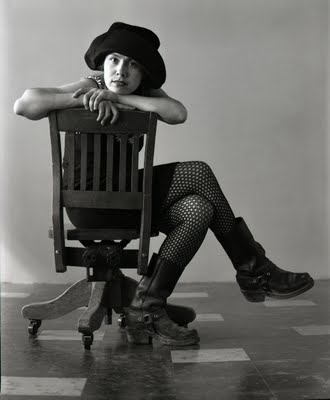
It was in 1999 or perhaps 1998 that I received a phone call from my friend and white-collar crime investigator Adrian du Plessis. He told me that he had a friend called Nina who he thought was a promising photographer. He asked me for advice on equipment he should buy for her. He then asked me if I would mentor her for a while or give her some lessons> I wasn’t all that keen but I could not refuse du Plessis. I don’t remember all the details on how I contacted Nina or if she contacted me. Nina showed up at my studio and I was startled to see a young woman who looked like a young girl who really was a young woman.
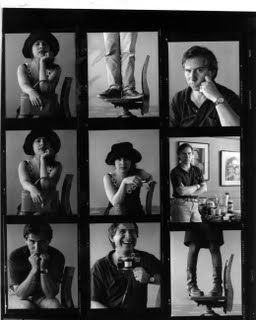
She had been born in British Guiana and she seemed to have gypsy blood. Nina and I did a mano a mano. I had never done this before and I have never done it since. She was really good and she knew what she wanted to do. We shared my camera and one roll of 220 film. That means that there were 18 (two were blanks we didn't shoot) exposures. We took turns at taking each other’s picture.

You can see all 18 here. I have always felt guilty over the fact that while I may have taught Nina a few things about photography I ended up taking her picture and she became one of the best nude models I ever had. She is now living in Spain and just wish she would return. I just wish, if indeed she has Gypsy blood, that she might feel restless and move.
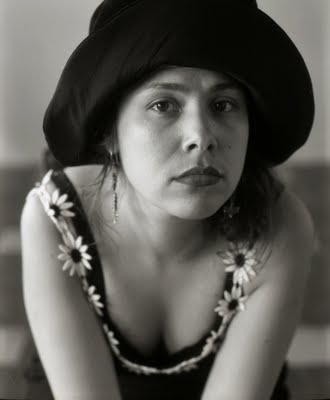

My house was magnificent, and far too large for one person. It had a verandah from which one had a very fine view of the hills in the distance, and at the back it had a small set of buildings known locally as ‘servants' quarters’. These were intended for the use of a maid or a cook. I had no need to employ a cook, as I took all my meals at a nearby restaurant called Las Cabanas, a splendid Graham Greene-ish sort of place into which chickens sometimes wandered and pecked about at one's feet.
From How I became the proprietor of a house of ill-repute by Alexander McCall Smith
Copyright © 2005, The Royal Society of Medicine
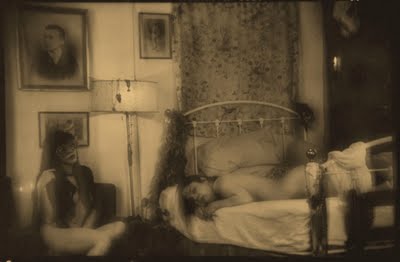
There is a most interesting little true by Alexander McCall Smith (he, the author of 1 Ladies Detective Agency series) about a house of ill-repute. The story is here.
I would never consider myself an expert on houses of ill-repute except to say that I went to two of them (one the infamous La Huerta in Acapulco) invited by the then chief of the Mexican Judicial Police in Acapulco and previously when he was a government lawyer in the port city of Veracruz. I visited Veracruz for the last time in 1974 before Rosemary and our two daughters drove up to settle in Vancouver. Rosemary and I had a romantic weak spot for Veracruz. We had begun to know each other well there when we visited my mother who taught at the Alcoa Aluminum School for the children of the engineers. Rosemary had insisted I oil the door hinges of the separate rooms my mother gave us. Rosemary and I were in Veracruz for at last fling of that previous romance. I had a drink in the Zócalo with my friend Licenciado Felipe Ferrer Junco. He had been my neighbour in Mexico City when he was a lawyer for Mexican Social Security while his wife Marcela (with a gun in her purse) was the bodyguard for some highfalutin government official. Ferrer Junco asked me, "How can you possibly leave Mexico for Vancouver and never have visited a "prostíbulo" (a scary sounding word in Spanish for house of ill-repute)?
We agreed to meet that evening and he drove me to a dark place that had bead curtains like in American movies set in clubas of Moroccan Kasbah. A short dark man (as far removed from Jean Gabin's Pépé le Moko) was dancing with a very young and beautiful girl. They were dancing so close he seemed to be wearing her as his tie. I mentioned to Felipe, as we drank our cubas, how attractive the young girl was. "Don't even look in his direction," he warned me, "He is the chief of police here." As the man turned, I spotted the Smith & Wesson tucked in his waist. It must must have left black and blue marks on the young girl.
At La Huerta (it burned down in the late 80s) my escort was Ferrer Junco, this time in his capacity of chief of the Mexican Judicial Police of Acapulco. The "club" had been world- famous for years for its extraordinary and beautiful young girls. To me they looked like they were somewhat long in the tooth. Go-go clubs were encroaching on La Huerta's exclusivity. We were offered free drinks and we were fussed over by a most obsequious madam, "Lo que quieran, estamos aquí para complacerlos." (Whatever you want we are here to please you). I pointed at my camera and Felipe ordered the woman to take me to photograph whatever I might want to photograph. This is the story behind the pictures you see here.
My interest in houses of ill-repute had occurred earlier around 1959 when my mother, my grandmother and I lived in an apartment on Avenida Insurgentes Sur in Mexico City. It was a very nice but busy avenue that took cars and buses to the more fashionable southern section of the city and its university. Below us was our friend Daniel Guridi Árregui's gun shop.
At the time I had an Edmond Scientific 4-inch reflector telescope and I would go to the roof to look at the moon and the planets. At least that is what my mother and grandmother thought. They did not know that the house next to our aparment was a clandestine house of "malas mujeres" or bad women as my grandmother euphemistically called prostitutes. On the roof I would point my telescope downwards and while I saw lots of great foreplay, the venetian blinds always were drawn at the "moment of truth".

My adventures on the roof ended one night, around 2 in the morning when a man rang our bell. He was drunk and he wanted my grandmother to let him in. It was then that I realized my grandmother had known all along. "Señor, vaya al lado." (Sir, go next door.). A week later we had moved to a better place, unbeknownst to me, one block from the very house where Edward Weston had photographed his pal Tina Modotti nude on the roof.
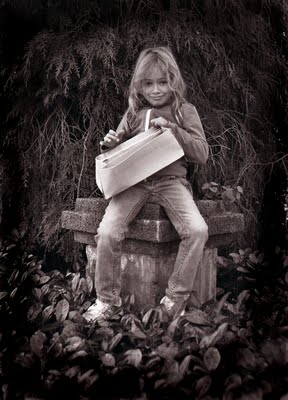
At 12 Rebecca has reached that threshold of adolescence which is marked by some confusion. I think it has come much earlier that it ever did for me.
In the 9th grade I wsa at St Edward’s High School, a Catholic boarding institution in Austin, Texas. I was barely 15. I remember making a scrap wood and tree branch shelter out in the bush with my friend John Straney. We would sit down and play the game of memorizing the correct names for all the WWII German fighter planes, bombers, tanks and battles. It was our secret hiding place. By the second semester John was no longer interested. I could not play the game alone.
Before I had moved from Buenos Aires to Mexico City in 1952 (I was 10) I had been playing toy soldiers with my Filipino cousin Robby. We had American GIs. My favourite had a bazooka on his shoulder. The nasty German and Japanese soldiers we blew up with our imagination. We dug little foxholes in my mother’s garden for our own version of the Battle of the Bulge. We flooded my mother's flower beds with a hose for the Battle of Leyte Gulf and fought each other as to which of us would say, "I shall return." In 1953 Robby and his family moved to Mexico. We followed a year later. When we arrived at the Mexico City airport I was shocked to see that Robby was taller and he had something on his face that I had never seen before. They were pimples. He did not want to play toy soldiers with me.
I would think that Rebecca will soon abandon the on-line computer game of dressing up celebrities. One day soon she will tire of Nancy Drew. I should not speed this up as soon she will not want to spend Saturdays with her boring grandparents. After all there will be all those boys to conquer.
That is why it is a pleasure to watch Lauren (7) play mostly by herself when she is nt being read by Rebecca or Rosemary. I love to watch her slide in her socks on our wooden living room floor. At home she plays for hours with her large dollhouse. This past Saturday I delighted in watching her play her shoebox and rubber band guitar. The power of the imagination of a child must be kept for as long as possible. I will be most careful not to tell either Rebecca or Lauren to grow up.
Oskar would approve.

It was in 1999 or perhaps 1998 that I received a phone call from my friend and white-collar crime investigator Adrian du Plessis. He told me that he had a friend called Nina who he thought was a promising photographer. He asked me for advice on equipment he should buy for her. He then asked me if I would mentor her for a while or give her some lessons> I wasn’t all that keen but I could not refuse du Plessis. I don’t remember all the details on how I contacted Nina or if she contacted me. Nina showed up at my studio and I was startled to see a young woman who looked like a young girl who really was a young woman.

She had been born in British Guiana and she seemed to have gypsy blood. Nina and I did a mano a mano. I had never done this before and I have never done it since. She was really good and she knew what she wanted to do. We shared my camera and one roll of 220 film. That means that there were 18 (two were blanks we didn't shoot) exposures. We took turns at taking each other’s picture.

You can see all 18 here. I have always felt guilty over the fact that while I may have taught Nina a few things about photography I ended up taking her picture and she became one of the best nude models I ever had. She is now living in Spain and just wish she would return. I just wish, if indeed she has Gypsy blood, that she might feel restless and move.


A House of Ill Repute
Tuesday, October 20, 2009
My house was magnificent, and far too large for one person. It had a verandah from which one had a very fine view of the hills in the distance, and at the back it had a small set of buildings known locally as ‘servants' quarters’. These were intended for the use of a maid or a cook. I had no need to employ a cook, as I took all my meals at a nearby restaurant called Las Cabanas, a splendid Graham Greene-ish sort of place into which chickens sometimes wandered and pecked about at one's feet.
From How I became the proprietor of a house of ill-repute by Alexander McCall Smith
Copyright © 2005, The Royal Society of Medicine

There is a most interesting little true by Alexander McCall Smith (he, the author of 1 Ladies Detective Agency series) about a house of ill-repute. The story is here.
I would never consider myself an expert on houses of ill-repute except to say that I went to two of them (one the infamous La Huerta in Acapulco) invited by the then chief of the Mexican Judicial Police in Acapulco and previously when he was a government lawyer in the port city of Veracruz. I visited Veracruz for the last time in 1974 before Rosemary and our two daughters drove up to settle in Vancouver. Rosemary and I had a romantic weak spot for Veracruz. We had begun to know each other well there when we visited my mother who taught at the Alcoa Aluminum School for the children of the engineers. Rosemary had insisted I oil the door hinges of the separate rooms my mother gave us. Rosemary and I were in Veracruz for at last fling of that previous romance. I had a drink in the Zócalo with my friend Licenciado Felipe Ferrer Junco. He had been my neighbour in Mexico City when he was a lawyer for Mexican Social Security while his wife Marcela (with a gun in her purse) was the bodyguard for some highfalutin government official. Ferrer Junco asked me, "How can you possibly leave Mexico for Vancouver and never have visited a "prostíbulo" (a scary sounding word in Spanish for house of ill-repute)?
We agreed to meet that evening and he drove me to a dark place that had bead curtains like in American movies set in clubas of Moroccan Kasbah. A short dark man (as far removed from Jean Gabin's Pépé le Moko) was dancing with a very young and beautiful girl. They were dancing so close he seemed to be wearing her as his tie. I mentioned to Felipe, as we drank our cubas, how attractive the young girl was. "Don't even look in his direction," he warned me, "He is the chief of police here." As the man turned, I spotted the Smith & Wesson tucked in his waist. It must must have left black and blue marks on the young girl.
At La Huerta (it burned down in the late 80s) my escort was Ferrer Junco, this time in his capacity of chief of the Mexican Judicial Police of Acapulco. The "club" had been world- famous for years for its extraordinary and beautiful young girls. To me they looked like they were somewhat long in the tooth. Go-go clubs were encroaching on La Huerta's exclusivity. We were offered free drinks and we were fussed over by a most obsequious madam, "Lo que quieran, estamos aquí para complacerlos." (Whatever you want we are here to please you). I pointed at my camera and Felipe ordered the woman to take me to photograph whatever I might want to photograph. This is the story behind the pictures you see here.
My interest in houses of ill-repute had occurred earlier around 1959 when my mother, my grandmother and I lived in an apartment on Avenida Insurgentes Sur in Mexico City. It was a very nice but busy avenue that took cars and buses to the more fashionable southern section of the city and its university. Below us was our friend Daniel Guridi Árregui's gun shop.
At the time I had an Edmond Scientific 4-inch reflector telescope and I would go to the roof to look at the moon and the planets. At least that is what my mother and grandmother thought. They did not know that the house next to our aparment was a clandestine house of "malas mujeres" or bad women as my grandmother euphemistically called prostitutes. On the roof I would point my telescope downwards and while I saw lots of great foreplay, the venetian blinds always were drawn at the "moment of truth".

My adventures on the roof ended one night, around 2 in the morning when a man rang our bell. He was drunk and he wanted my grandmother to let him in. It was then that I realized my grandmother had known all along. "Señor, vaya al lado." (Sir, go next door.). A week later we had moved to a better place, unbeknownst to me, one block from the very house where Edward Weston had photographed his pal Tina Modotti nude on the roof.
That Shoebox Guitar
Monday, October 19, 2009

At 12 Rebecca has reached that threshold of adolescence which is marked by some confusion. I think it has come much earlier that it ever did for me.
In the 9th grade I wsa at St Edward’s High School, a Catholic boarding institution in Austin, Texas. I was barely 15. I remember making a scrap wood and tree branch shelter out in the bush with my friend John Straney. We would sit down and play the game of memorizing the correct names for all the WWII German fighter planes, bombers, tanks and battles. It was our secret hiding place. By the second semester John was no longer interested. I could not play the game alone.
Before I had moved from Buenos Aires to Mexico City in 1952 (I was 10) I had been playing toy soldiers with my Filipino cousin Robby. We had American GIs. My favourite had a bazooka on his shoulder. The nasty German and Japanese soldiers we blew up with our imagination. We dug little foxholes in my mother’s garden for our own version of the Battle of the Bulge. We flooded my mother's flower beds with a hose for the Battle of Leyte Gulf and fought each other as to which of us would say, "I shall return." In 1953 Robby and his family moved to Mexico. We followed a year later. When we arrived at the Mexico City airport I was shocked to see that Robby was taller and he had something on his face that I had never seen before. They were pimples. He did not want to play toy soldiers with me.
I would think that Rebecca will soon abandon the on-line computer game of dressing up celebrities. One day soon she will tire of Nancy Drew. I should not speed this up as soon she will not want to spend Saturdays with her boring grandparents. After all there will be all those boys to conquer.
That is why it is a pleasure to watch Lauren (7) play mostly by herself when she is nt being read by Rebecca or Rosemary. I love to watch her slide in her socks on our wooden living room floor. At home she plays for hours with her large dollhouse. This past Saturday I delighted in watching her play her shoebox and rubber band guitar. The power of the imagination of a child must be kept for as long as possible. I will be most careful not to tell either Rebecca or Lauren to grow up.
Oskar would approve.
Sunday, October 18, 2009
Seven times a day I praise you.
Ps. 119:164

Breviarium for the use of Dominican Nuns
Germany : s.n., ca. 1430
LAT 096 B84g
This breviarium was penned in upright Gothic (lettres batardes) with eighteen lines to the page in black, red and blue; including numerous large initials on the finest vellum. Inside, a twelve page calendar is preceded by a circular sun and moon with double circles in gold, silver, red, blue and green. The first page and page 167 are decorated in gold and other colours, with decorative borders and wide margins. The breviarium comprises 536 pages and has its original cover made of brown calf skin over oak boards. The locking clasps on the cover are missing; it is also surrounded by borders that were blind tooled with the words Ave Maria Gratia plena. This is considered to be a very beautiful German MS. in perfect condition, circa 1430.
The breviarium was purchased for the Vancouver Public Library in the 1930s from a retired janitor in Kamloops; it may have been brought to Canada from Germany by a pioneering family.
Photo Above from Vancouver Public Library Special Collections Web Site

I had forgotten that palpable excitement that would rush through me when in my youth I would enter a good library. For close to 35 years I have frequented bookstores and spent lots of money buying books. There is little space left for them in our house. The public library has become a practical option. I had forgotten the wonder of randomly finding something that would suddenly interest me. I had forgotten that library staple, a stack called “New Books” and the pleasure of picking up each book and reading the book jacket.
On Saturday, after lunch I took Rebecca and Lauren to the main branch of our public library. I had done my homework the day before. I told the girls, “I have a surprise for you on the 7th floor. We could take the elevator but I would rather prolong the mystery by insisting we take the escalators. By the time we got to the 7th floor and on side Rebecca read the sign that said “Special Collections” she asked me what it was we were going to see. “Wait a few minutes and you will see,” I answered.
There were two female librarians. One of them looked extremely serious while the other one did not look like she had ever cracked a smile since books adopted the codex style. I decided she was the better bet and showed her an item that was underlined in a sheet of paper I had brought with me: Breviarium for the use of Dominican nuns.... 096 B846.
Both women disappeared for a while and they returned with a wheeled cart on which lay a smallish black box and a pillow. The more amenable of the two then put on a pair of cotton gloves and gestured to a nearby table. She placed the pillow on the table, opened the box and removed one of the nicest books I have ever seen that close. We all marveled at the sight and I asked the woman if she herself had ever seen it. She told us that she had been asked to show it a couple of times in the past. And she smiled!
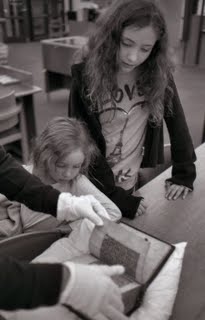
We went down the escalators and spent a pleasant afternoon looking at books in the children’s room which is most spacious. As we left for home with our booty (I had found a pop-up book on mummies that Lauren wanted to borrow and Rebecca, this time eschewing teen magazines took out three novels.) I experienced the realization that I had forgotten how exciting it is to visit libraries.
As soon as we got home I told Rebecca we were going to watch a film. She protested and told me she wanted to read. I was not going to argue with that! She lay down on our living room’s psychiatric couch to read her novel.
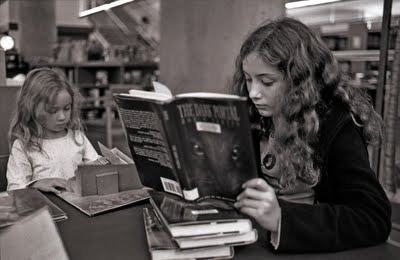
After dinner we watched from the series (The Artists’ Specials) the film Monet – Shadows & Light. It was beautifully done. As soon as it was over I brought into the den a nice big picture book from my collection called Impressionist Women by Edward Lucie-Smith. Rebecca, Lauren and Hilary looked at the pictures. Some were almost like still images from the film we had seen. Rebecca pronounced the name of the painters in her oh-so-nice French, Berthe Morisot, Eva Gonzales, Mary Cassat, Camille Pissarro, Edouard Manet, Auguste Renoir, Edgar Degas, etc. I felt content as I took the girls home.
Lauren had her own prize, too. Before the film we had seen the short film Madeline’s Rescue based upon the book by Ludwig Bemelmans and splendidly narrated by Christopher Plummer.
Of course the two films I checked out from the Vancouver Public Library.
Special Collections
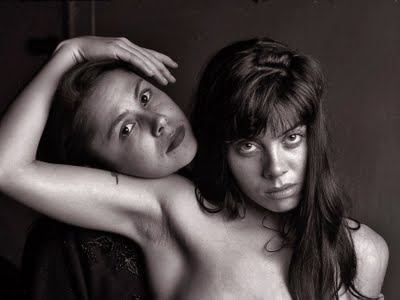
My perception of how shoes affect how I judge people was fundamentally changed some 12 years ago when two of my friends, Bif and Nina walked around in Dr. Martens and clunky boots. I told them that their shoe wear took away from their femininity. Bif with her tattoos and generous voice laughed at me while Nina, after a while, was bothered by my constant criticism. The two women must have had a discussion about it because they told me to wait for them in my studio. They assured me that my opinion on their clunky footwear would change. And it did.
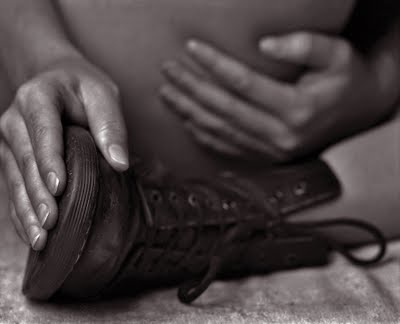

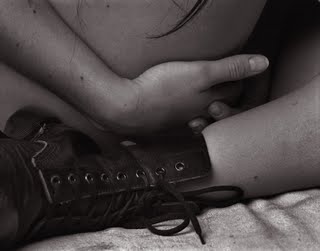
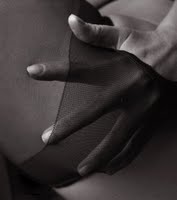
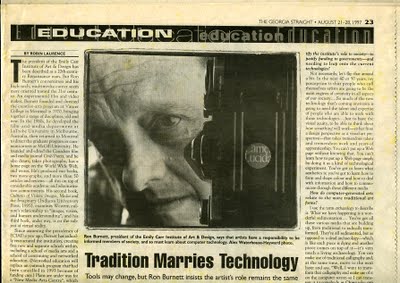
It may have been some 10 years ago that at a photographic group show at the Exposure Gallery (it was then on Beatty Street) I was chatting with a pleasant and young female photographer who had a picture on the wall next to mine. It was a show in which we were invited to use basic and or primitive box cameras. I think it was called The Low Tech Show. The pleasant female photographer, who was a recent graduate of the then Emily Carr Institute of Art & design, (it now has the far loftier name Emily Carr University of Art + Design with the corresponding accreditation and that mysterious replacement of & for a +) told me, “I really admire you Alex. I could never be a commercial photographer. I could never photograph sewing machines.”
Some 15 years before an apologetic Vancouver Magazine art director, Rick Staehling had called me and assigned me to do just that. I took the job because honest money from any quarters is honest money. This young woman somehow knew about my sewing machine job. I looked at her and kept my temper knowing that had she not been a woman I would have punched him on the nose!
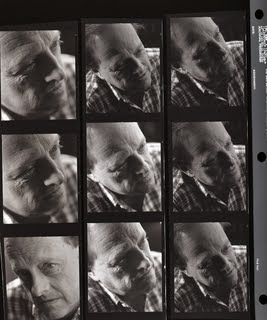
My relationship with the institution that is Emily Carr has been a varied one. For about 13 years I was an artist/techer in the Outreach Program of Emily Carr Institute of Art & Design that was pioneered by wonder woman Nini Baird. We artist/teachers (as we were called) went to teach photography, printmaking, painting, etc to remote communities of the interior. They were usually on weekends. The program was partially funded by the Province. It was Baird’s contention that the folks in the interior paid some sort of culture tax yet got nothing for it. Baird left Emily Carr for the Knowledge Network and the program at the institute soon died.
I was later called with some regularity to teach something called Photographics to fourth year design students. I was never asked to show any kind of qulifications. I was hired on the merits of being a photographer who worked in that real outside world, that commercial world. Others were hired like designer Ray Mah and photographer James O’Mara.

I was particularly proud that one year I had my students design a record album, the inside sleeve and the centre of the record. I told my class that I was going to bring a real, live rock star. I brought Art Bergmann. I told the class that Bergmann had to approve of their individual designs and that he was going to be difficult about this. My students rose to the challenge. I remember putting in a expense for a bottle of Chivas Regal. “What’s this?” the institute accountant asked me. “You don’t expect me to bring in someone to pose for my class without paying them, do you?” I told her. They paid.After those Photographics classes I was never called again.
In early August 1997 the Straight assigned me to photograph the new president of the institute, Ron Burnett. When I went to his office he confessed a love for photography and that hatched an idea in my head. I had forgotten about this until I found Burnett’s files today and noticed the Straight tear sheet. I wondered how I had taken this photograph. The contents of the file soon refreshed my memory. I took 10 pictures of him with b+w negative film. I processed the film and chose on of the frames to print. I printed it and put a stiff cardboard backing. I wondered why I had done that. It seems I placed the print/cardboard combination on a stand outside and then put an old Pentax S-3 on its side on a tripod. I had the shutter locked on B and must of somehow placed Roland Barthes’ Camera Lucida in front. I am not sure if the camera had a lens or not. With cloudy day light I photographed the setup with my medium format Mamiya RB-67.
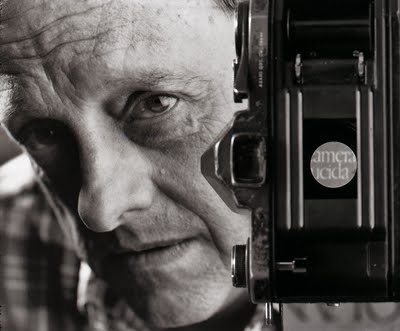
I never saw Ron Burnett again. I looked at his sad face today and wondered why he had stared at me like that. Burnett has been at the institute, now turned university, for 14 years. I wonder if he is more cheerful now. I wonder if the art students that are graduating from his university are now reluctantly willing to “sell their souls” to commercial endeavours while pursuing their art. Or are they like that young woman in my past who was so proud of her art that she might have opted for being a restaurant server than to photograph sewing machines?
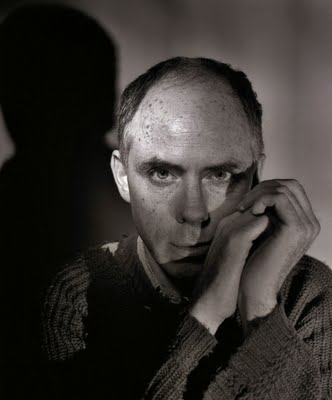
Theatre is much like film. Casts and the crew who work with them have a pecking order. There are positions in film like the grips. I have no real idea of what they do. Do they hold things? Many in theatre, like in film, are essential, some are also unsung. One of them is the Fight Director. In films like The Matrix we would all understand that the Fight Director or fight sequence director would be most important. A broadsword fight in a Bard of the Beach production of Macbeth would also be on that same league.
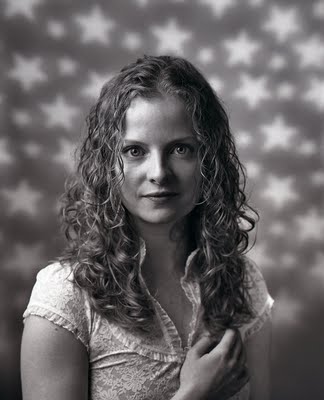
Then you go with your daughter, as I did tonight, to the opening performance of American playwright William Gibson’s, The Miracle Worker presented by the Vancouver Playhouse Theatre Company. You would never consider that a fight director would have any kind of relevance in a play based on the early life of Helen Keller. Fight scenes here? Impossible!
Yet there are fights in this extremely fine production directed by Meg Roe (I remember her well from her killer role as an actress playing an autistic youth in the recent Vancouver Playhouse production of Toronto, Mississippi) which use scissor, spoons and other thrown objects that are so central to this play that without them The Miracle Worker would fizzle. It is a fight between a headstrong little girl who is unable to connect between the signs for letters, and the real objects, things and people they define, and a just-as-headstrong woman of 20 (not a teenager!) with a past that might just prevent her from finding a solution to the process of thought through language.

The unsung hero of that virtuoso spoon fight is Fight Director David Bloom seen here in picture above left. During the scuffle for the fallen spoon the theatre was so quiet that all I could hear was that spoon drop.
Two little girls play Helen Keller, Margot Berner and Emma Grabinsky. If I understand well my program notes my daughter Hilary and I saw Margot Berner tonight. She was superb in her battle of wits with her nurse and teacher Annie Sullivan played by Anna Cummer.
I must diverge here to give my account of my extraordinary experience in having Cummer in my studio back in 2005. I happened to ask her if she could cry on demand. I had been lucky before in that I had photographed two acresses who could do just that. Cummer looked at me and left the studio. A few minutes later she returned and stood in front of my camera with a face that was ravaged by sorrow. Little tears began to pour down her eyes.
In this production of The Miracle Worker all the other actors, Hamza Adam as Percy/Doctor, Tom Butler as Captain Keller, Jennifer Clement as Kate Keller, Marci T. House as Viney and Bridget O’Sullivan as Aunt Ev were good given that it was just about impossible to compete with Cummer and Berner's strong performances in roles designed to be just that.
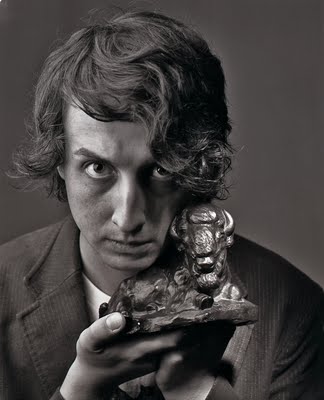
For me there was one other actor who stood out. He is one of my favourites in town. Ryan Beil played James Keller, a young man who does not seem to know how to please his father. Beil has a kind of Stan Laurel universal face that can adapt to any situation. I thought he was excellent in the Main Street Production of Glengarry Glen Ross. I ache to see Beil in a comedy that goes beyond the role limitations of this summer’s Bard on the Beach production of The Comedy of Errors. Beil can be funny and especially so if let loose!
As Hilary and I watched the battle of wits between little Helen Keller and Annie Sullivan I kept whispering in her ear, “Lauren and Rebecca (my granddaughters and Hilary’s daughters) are easy in comparison to this!”
It was around 11pm that Hilary called to say, “Lauren was impossible. She threw pens and pencils with such force against the kitchen stove, that she broke them. She refused to write down anything for her dictée. Her father has grounded her, including no TV until Monday.”
I wonder if David Bloom might have approved. In the play Annie Sullivan says, "Obedience without understanding is a blindness, too." What would Sullivan have opined on grounding?
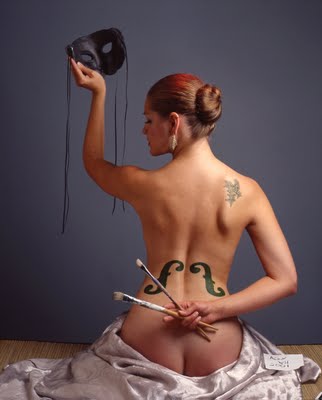
Peggy’s story as I see it from a thick file of photographs, began in August of 2001 and ended (photographically) in an emotional session in my studio in January 2004.
It was in August of 2001 that I received a most interesting assignment from the Straight’s art director Annette Waurick. In retrospect Waurick was the best they ever had. She was let go and ended up doing just nicely for Homemakers in Toronto. In those days the Fall Arts Preview was a big thing at the Straight. They insisted on original photographs (no handouts, please from the arts organizations!) and they would get very upset if any picture in the Straight somehow appeared in the Vancouver Sun.

There was a nice aggressive competition that suited me fine. Waurick’s request was that I “rip off” Man Ray’s famous photograph of Kiki with f-holes on her back and to somehow adapt it in colour to reflect the arts. This meant that I needed a subject who would pose undraped. I immediately called Cori Caulfield as she had and has a most beautiful back (and everything else). I liked the idea that my subject would reflect one of the arts, in this case that of dance. Cori was apologetic. “Alex I would love to pose for you but I am extremely busy. I am going to send you one of my best ballet students. She is 21.”
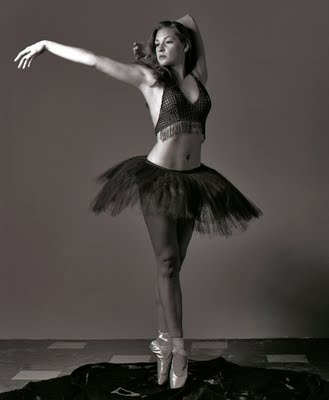
Peggy arrived. By then I knew she had a green tattoo of a frog on her right shoulder. I had told her to have her girlfriend draw the f-holes with a green marker. My Argentine painter friend had lent me his brushes and I had purchased at a pottery sale a mask to represent theatre.
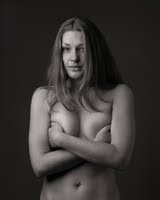
Man Ray had placed a piece of paper on the right hand bottom of his picture with his name and date. I did the same. Working with Peggy was a pleasure. She had never posed for a camera before but she was a natural and told me that she liked being photographed and wanted me to photograph her again. This I did most willingly.
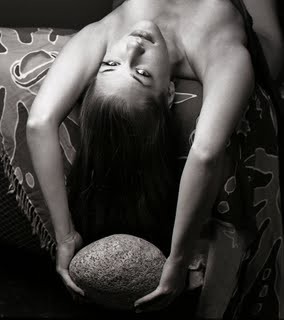
At the time she had an abusive boyfriend who did not seem to understand all of Peggy’s facets. Peggy had studied to be a kick boxer. “Alex (Peggy’s boyfriend) does not understand my career as a ballerina and never attends any of the performances. He does not understand how I can be a boxer. He is aware that I am sexy but has no idea of my sensuality. About all I do that he agrees with is our mutual interest in boarding. I am not getting along with them. Today we broke up.”

So I took five pictures of Peggy (September 2001). One as a ballerina, one as a boxer (alas this one has some nudity so I cannot show it), one as a sensual woman (the one with the rock and it has been cropped for propriety) and one as a boarder. The fifth one was all my idea. “I am going to photograph you as yourself. You are going to pose nude from head to toe and I will photograph you from the waist up. She posed, hid her breasts behind her arms, looked at my camera and began to cry.
I had a show at the Simon Patrich Gallery a few weeks later and the pictures were up. Peggy arrived with Alex. They had reconciled their differences. But that was not to be as Peggy later told me that the police had placed her on a restraining order as she had beaten up Alex in a confrontation. It was all over between them.

In August 2002 Peggy came back to my studio and I photographer her mostly undraped. I was particularly happy with the pictures showing how graceful as you see here where I used a mosquito netting to hide all the “stuff”.
In December of the same years, all pretenses of using clothing went out the window and I took nudes. I was particularly happy in making use of Peggy’s flexibility to advantage in taking pictures of her foot ever so close to her face. Peggy was cheerful and a delight to photograph. I had lots of fun.
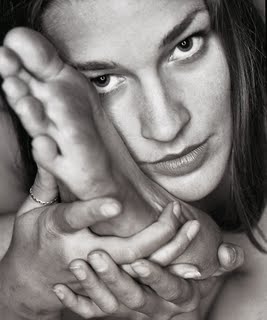
Her cheerfulness almost disappeared the last time I photographed her in January, 2004. On the phone before we made our shooting date she told me, “Alex I am no longer dancing ballet. But I am dancing.” I knew. She had become a stripper. She had moved to Vancouver Island and had a large dog. I explained to her that I wanted her to bring all her ballet paraphernalia plus all the new stuff like red pumps and her dancer clothing.
I instructed Peggy to put on her ballet outfit and then once I had my light ready I told her to take it all off slowly, beginning with her pointe shoes and then to dress up in her new outfit. This was a tearful experience as she went from her ballerina past to her exotic dancer present and future.
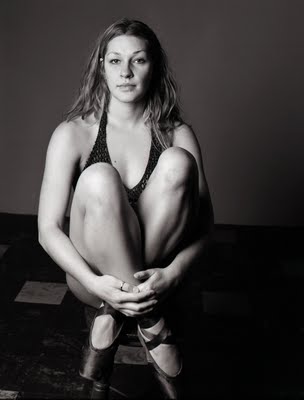
Not too long after my friend ecdysiast connoisseur Sean Rossiter and I went to see Peggy perform at a club in New Westminster. It was a strange place as the club had a hermetically sealed room (all glass walls) in which the smokers could watch the show. Peggy was the best pole dancers Rossiter and I ever saw. We saw her again at the last days of a club in Port Moody. We had a nice chat with Peggy after she confirmed again her expertise with a pole and with a dancing style that had not equal except for my memories of having scene jazz dancer trained Jackie Coleman at the No 5 Orange Street in the late 70s.
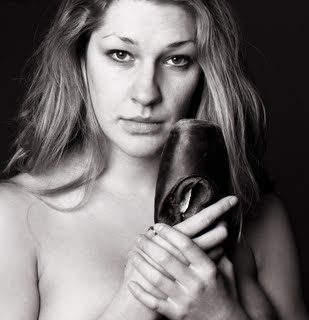
After that performance at the Port Moody club I did not see Peggy again and she disappeared. Even then she was not computer savvy and even though she told me she was going to try to learn she was off my map.
I found her today. She is convalescing from an accident where she tore a tendon in one foot and is unable to work. I am not a liberty to disclose here how it happened. Since that last time I saw her she decided to improve on nature’s bounty and had her breasts fixed. This procedure brought some complications that almost killed her. But Peggy is all cheer with her dog and she is quietly living in Victoria.

As soon as she gets better she told me that she will come to Vancouver and pose for me. The idea is comforting to me; almost as comforting as having found her. She may not be computer savvy but she did respond to an e-mail of mine with her Blackberry and even sent me a snap she took with it.
I find it hard to believe that the young girl that first came to my studio at 21 is now 30.
Seven times a day I praise you.
Ps. 119:164

Breviarium for the use of Dominican Nuns
Germany : s.n., ca. 1430
LAT 096 B84g
This breviarium was penned in upright Gothic (lettres batardes) with eighteen lines to the page in black, red and blue; including numerous large initials on the finest vellum. Inside, a twelve page calendar is preceded by a circular sun and moon with double circles in gold, silver, red, blue and green. The first page and page 167 are decorated in gold and other colours, with decorative borders and wide margins. The breviarium comprises 536 pages and has its original cover made of brown calf skin over oak boards. The locking clasps on the cover are missing; it is also surrounded by borders that were blind tooled with the words Ave Maria Gratia plena. This is considered to be a very beautiful German MS. in perfect condition, circa 1430.
The breviarium was purchased for the Vancouver Public Library in the 1930s from a retired janitor in Kamloops; it may have been brought to Canada from Germany by a pioneering family.
Photo Above from Vancouver Public Library Special Collections Web Site

I had forgotten that palpable excitement that would rush through me when in my youth I would enter a good library. For close to 35 years I have frequented bookstores and spent lots of money buying books. There is little space left for them in our house. The public library has become a practical option. I had forgotten the wonder of randomly finding something that would suddenly interest me. I had forgotten that library staple, a stack called “New Books” and the pleasure of picking up each book and reading the book jacket.
On Saturday, after lunch I took Rebecca and Lauren to the main branch of our public library. I had done my homework the day before. I told the girls, “I have a surprise for you on the 7th floor. We could take the elevator but I would rather prolong the mystery by insisting we take the escalators. By the time we got to the 7th floor and on side Rebecca read the sign that said “Special Collections” she asked me what it was we were going to see. “Wait a few minutes and you will see,” I answered.
There were two female librarians. One of them looked extremely serious while the other one did not look like she had ever cracked a smile since books adopted the codex style. I decided she was the better bet and showed her an item that was underlined in a sheet of paper I had brought with me: Breviarium for the use of Dominican nuns.... 096 B846.
Both women disappeared for a while and they returned with a wheeled cart on which lay a smallish black box and a pillow. The more amenable of the two then put on a pair of cotton gloves and gestured to a nearby table. She placed the pillow on the table, opened the box and removed one of the nicest books I have ever seen that close. We all marveled at the sight and I asked the woman if she herself had ever seen it. She told us that she had been asked to show it a couple of times in the past. And she smiled!

We went down the escalators and spent a pleasant afternoon looking at books in the children’s room which is most spacious. As we left for home with our booty (I had found a pop-up book on mummies that Lauren wanted to borrow and Rebecca, this time eschewing teen magazines took out three novels.) I experienced the realization that I had forgotten how exciting it is to visit libraries.
As soon as we got home I told Rebecca we were going to watch a film. She protested and told me she wanted to read. I was not going to argue with that! She lay down on our living room’s psychiatric couch to read her novel.

After dinner we watched from the series (The Artists’ Specials) the film Monet – Shadows & Light. It was beautifully done. As soon as it was over I brought into the den a nice big picture book from my collection called Impressionist Women by Edward Lucie-Smith. Rebecca, Lauren and Hilary looked at the pictures. Some were almost like still images from the film we had seen. Rebecca pronounced the name of the painters in her oh-so-nice French, Berthe Morisot, Eva Gonzales, Mary Cassat, Camille Pissarro, Edouard Manet, Auguste Renoir, Edgar Degas, etc. I felt content as I took the girls home.
Lauren had her own prize, too. Before the film we had seen the short film Madeline’s Rescue based upon the book by Ludwig Bemelmans and splendidly narrated by Christopher Plummer.
Of course the two films I checked out from the Vancouver Public Library.
Special Collections
Bif & Nina's Dainty Footwear
Saturday, October 17, 2009

My perception of how shoes affect how I judge people was fundamentally changed some 12 years ago when two of my friends, Bif and Nina walked around in Dr. Martens and clunky boots. I told them that their shoe wear took away from their femininity. Bif with her tattoos and generous voice laughed at me while Nina, after a while, was bothered by my constant criticism. The two women must have had a discussion about it because they told me to wait for them in my studio. They assured me that my opinion on their clunky footwear would change. And it did.




Emily Carr's Melancholy Ron Burnett
Friday, October 16, 2009

It may have been some 10 years ago that at a photographic group show at the Exposure Gallery (it was then on Beatty Street) I was chatting with a pleasant and young female photographer who had a picture on the wall next to mine. It was a show in which we were invited to use basic and or primitive box cameras. I think it was called The Low Tech Show. The pleasant female photographer, who was a recent graduate of the then Emily Carr Institute of Art & design, (it now has the far loftier name Emily Carr University of Art + Design with the corresponding accreditation and that mysterious replacement of & for a +) told me, “I really admire you Alex. I could never be a commercial photographer. I could never photograph sewing machines.”
Some 15 years before an apologetic Vancouver Magazine art director, Rick Staehling had called me and assigned me to do just that. I took the job because honest money from any quarters is honest money. This young woman somehow knew about my sewing machine job. I looked at her and kept my temper knowing that had she not been a woman I would have punched him on the nose!

My relationship with the institution that is Emily Carr has been a varied one. For about 13 years I was an artist/techer in the Outreach Program of Emily Carr Institute of Art & Design that was pioneered by wonder woman Nini Baird. We artist/teachers (as we were called) went to teach photography, printmaking, painting, etc to remote communities of the interior. They were usually on weekends. The program was partially funded by the Province. It was Baird’s contention that the folks in the interior paid some sort of culture tax yet got nothing for it. Baird left Emily Carr for the Knowledge Network and the program at the institute soon died.
I was later called with some regularity to teach something called Photographics to fourth year design students. I was never asked to show any kind of qulifications. I was hired on the merits of being a photographer who worked in that real outside world, that commercial world. Others were hired like designer Ray Mah and photographer James O’Mara.

I was particularly proud that one year I had my students design a record album, the inside sleeve and the centre of the record. I told my class that I was going to bring a real, live rock star. I brought Art Bergmann. I told the class that Bergmann had to approve of their individual designs and that he was going to be difficult about this. My students rose to the challenge. I remember putting in a expense for a bottle of Chivas Regal. “What’s this?” the institute accountant asked me. “You don’t expect me to bring in someone to pose for my class without paying them, do you?” I told her. They paid.After those Photographics classes I was never called again.
In early August 1997 the Straight assigned me to photograph the new president of the institute, Ron Burnett. When I went to his office he confessed a love for photography and that hatched an idea in my head. I had forgotten about this until I found Burnett’s files today and noticed the Straight tear sheet. I wondered how I had taken this photograph. The contents of the file soon refreshed my memory. I took 10 pictures of him with b+w negative film. I processed the film and chose on of the frames to print. I printed it and put a stiff cardboard backing. I wondered why I had done that. It seems I placed the print/cardboard combination on a stand outside and then put an old Pentax S-3 on its side on a tripod. I had the shutter locked on B and must of somehow placed Roland Barthes’ Camera Lucida in front. I am not sure if the camera had a lens or not. With cloudy day light I photographed the setup with my medium format Mamiya RB-67.

I never saw Ron Burnett again. I looked at his sad face today and wondered why he had stared at me like that. Burnett has been at the institute, now turned university, for 14 years. I wonder if he is more cheerful now. I wonder if the art students that are graduating from his university are now reluctantly willing to “sell their souls” to commercial endeavours while pursuing their art. Or are they like that young woman in my past who was so proud of her art that she might have opted for being a restaurant server than to photograph sewing machines?
Bloom's Spoons
Thursday, October 15, 2009

Theatre is much like film. Casts and the crew who work with them have a pecking order. There are positions in film like the grips. I have no real idea of what they do. Do they hold things? Many in theatre, like in film, are essential, some are also unsung. One of them is the Fight Director. In films like The Matrix we would all understand that the Fight Director or fight sequence director would be most important. A broadsword fight in a Bard of the Beach production of Macbeth would also be on that same league.

Then you go with your daughter, as I did tonight, to the opening performance of American playwright William Gibson’s, The Miracle Worker presented by the Vancouver Playhouse Theatre Company. You would never consider that a fight director would have any kind of relevance in a play based on the early life of Helen Keller. Fight scenes here? Impossible!
Yet there are fights in this extremely fine production directed by Meg Roe (I remember her well from her killer role as an actress playing an autistic youth in the recent Vancouver Playhouse production of Toronto, Mississippi) which use scissor, spoons and other thrown objects that are so central to this play that without them The Miracle Worker would fizzle. It is a fight between a headstrong little girl who is unable to connect between the signs for letters, and the real objects, things and people they define, and a just-as-headstrong woman of 20 (not a teenager!) with a past that might just prevent her from finding a solution to the process of thought through language.

The unsung hero of that virtuoso spoon fight is Fight Director David Bloom seen here in picture above left. During the scuffle for the fallen spoon the theatre was so quiet that all I could hear was that spoon drop.
Two little girls play Helen Keller, Margot Berner and Emma Grabinsky. If I understand well my program notes my daughter Hilary and I saw Margot Berner tonight. She was superb in her battle of wits with her nurse and teacher Annie Sullivan played by Anna Cummer.
I must diverge here to give my account of my extraordinary experience in having Cummer in my studio back in 2005. I happened to ask her if she could cry on demand. I had been lucky before in that I had photographed two acresses who could do just that. Cummer looked at me and left the studio. A few minutes later she returned and stood in front of my camera with a face that was ravaged by sorrow. Little tears began to pour down her eyes.
In this production of The Miracle Worker all the other actors, Hamza Adam as Percy/Doctor, Tom Butler as Captain Keller, Jennifer Clement as Kate Keller, Marci T. House as Viney and Bridget O’Sullivan as Aunt Ev were good given that it was just about impossible to compete with Cummer and Berner's strong performances in roles designed to be just that.

For me there was one other actor who stood out. He is one of my favourites in town. Ryan Beil played James Keller, a young man who does not seem to know how to please his father. Beil has a kind of Stan Laurel universal face that can adapt to any situation. I thought he was excellent in the Main Street Production of Glengarry Glen Ross. I ache to see Beil in a comedy that goes beyond the role limitations of this summer’s Bard on the Beach production of The Comedy of Errors. Beil can be funny and especially so if let loose!
As Hilary and I watched the battle of wits between little Helen Keller and Annie Sullivan I kept whispering in her ear, “Lauren and Rebecca (my granddaughters and Hilary’s daughters) are easy in comparison to this!”
It was around 11pm that Hilary called to say, “Lauren was impossible. She threw pens and pencils with such force against the kitchen stove, that she broke them. She refused to write down anything for her dictée. Her father has grounded her, including no TV until Monday.”
I wonder if David Bloom might have approved. In the play Annie Sullivan says, "Obedience without understanding is a blindness, too." What would Sullivan have opined on grounding?
Pole Winner
Wednesday, October 14, 2009

Peggy’s story as I see it from a thick file of photographs, began in August of 2001 and ended (photographically) in an emotional session in my studio in January 2004.
It was in August of 2001 that I received a most interesting assignment from the Straight’s art director Annette Waurick. In retrospect Waurick was the best they ever had. She was let go and ended up doing just nicely for Homemakers in Toronto. In those days the Fall Arts Preview was a big thing at the Straight. They insisted on original photographs (no handouts, please from the arts organizations!) and they would get very upset if any picture in the Straight somehow appeared in the Vancouver Sun.

There was a nice aggressive competition that suited me fine. Waurick’s request was that I “rip off” Man Ray’s famous photograph of Kiki with f-holes on her back and to somehow adapt it in colour to reflect the arts. This meant that I needed a subject who would pose undraped. I immediately called Cori Caulfield as she had and has a most beautiful back (and everything else). I liked the idea that my subject would reflect one of the arts, in this case that of dance. Cori was apologetic. “Alex I would love to pose for you but I am extremely busy. I am going to send you one of my best ballet students. She is 21.”

Peggy arrived. By then I knew she had a green tattoo of a frog on her right shoulder. I had told her to have her girlfriend draw the f-holes with a green marker. My Argentine painter friend had lent me his brushes and I had purchased at a pottery sale a mask to represent theatre.

Man Ray had placed a piece of paper on the right hand bottom of his picture with his name and date. I did the same. Working with Peggy was a pleasure. She had never posed for a camera before but she was a natural and told me that she liked being photographed and wanted me to photograph her again. This I did most willingly.

At the time she had an abusive boyfriend who did not seem to understand all of Peggy’s facets. Peggy had studied to be a kick boxer. “Alex (Peggy’s boyfriend) does not understand my career as a ballerina and never attends any of the performances. He does not understand how I can be a boxer. He is aware that I am sexy but has no idea of my sensuality. About all I do that he agrees with is our mutual interest in boarding. I am not getting along with them. Today we broke up.”

So I took five pictures of Peggy (September 2001). One as a ballerina, one as a boxer (alas this one has some nudity so I cannot show it), one as a sensual woman (the one with the rock and it has been cropped for propriety) and one as a boarder. The fifth one was all my idea. “I am going to photograph you as yourself. You are going to pose nude from head to toe and I will photograph you from the waist up. She posed, hid her breasts behind her arms, looked at my camera and began to cry.
I had a show at the Simon Patrich Gallery a few weeks later and the pictures were up. Peggy arrived with Alex. They had reconciled their differences. But that was not to be as Peggy later told me that the police had placed her on a restraining order as she had beaten up Alex in a confrontation. It was all over between them.

In August 2002 Peggy came back to my studio and I photographer her mostly undraped. I was particularly happy with the pictures showing how graceful as you see here where I used a mosquito netting to hide all the “stuff”.
In December of the same years, all pretenses of using clothing went out the window and I took nudes. I was particularly happy in making use of Peggy’s flexibility to advantage in taking pictures of her foot ever so close to her face. Peggy was cheerful and a delight to photograph. I had lots of fun.

Her cheerfulness almost disappeared the last time I photographed her in January, 2004. On the phone before we made our shooting date she told me, “Alex I am no longer dancing ballet. But I am dancing.” I knew. She had become a stripper. She had moved to Vancouver Island and had a large dog. I explained to her that I wanted her to bring all her ballet paraphernalia plus all the new stuff like red pumps and her dancer clothing.
I instructed Peggy to put on her ballet outfit and then once I had my light ready I told her to take it all off slowly, beginning with her pointe shoes and then to dress up in her new outfit. This was a tearful experience as she went from her ballerina past to her exotic dancer present and future.

Not too long after my friend ecdysiast connoisseur Sean Rossiter and I went to see Peggy perform at a club in New Westminster. It was a strange place as the club had a hermetically sealed room (all glass walls) in which the smokers could watch the show. Peggy was the best pole dancers Rossiter and I ever saw. We saw her again at the last days of a club in Port Moody. We had a nice chat with Peggy after she confirmed again her expertise with a pole and with a dancing style that had not equal except for my memories of having scene jazz dancer trained Jackie Coleman at the No 5 Orange Street in the late 70s.

After that performance at the Port Moody club I did not see Peggy again and she disappeared. Even then she was not computer savvy and even though she told me she was going to try to learn she was off my map.
I found her today. She is convalescing from an accident where she tore a tendon in one foot and is unable to work. I am not a liberty to disclose here how it happened. Since that last time I saw her she decided to improve on nature’s bounty and had her breasts fixed. This procedure brought some complications that almost killed her. But Peggy is all cheer with her dog and she is quietly living in Victoria.

As soon as she gets better she told me that she will come to Vancouver and pose for me. The idea is comforting to me; almost as comforting as having found her. She may not be computer savvy but she did respond to an e-mail of mine with her Blackberry and even sent me a snap she took with it.
I find it hard to believe that the young girl that first came to my studio at 21 is now 30.
Tuesday, October 13, 2009
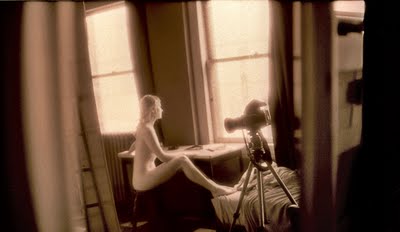
For many years I have put all my photographic eggs into the medium format basket. This means that I have taken most of my photographs with a Mamiya RB-67 with its 6x7 cm transparency or negative. Whenever I hold a 35mm camera, even that extra heavy tank that my Nikon F-3 with a motor drive is, I feel I am holding a toy. When all my printing happened strictly in the darkroom there were many negatives and transparencies that never saw the light of day. Now I like to make myself a large and strong cup of tea and look at some of my negatives wit a loupe. I am putting an extra effort into looking at pictures I took with those “small” cameras. Often the best excuse for using a 35camera (and still is) was its ability to let me shoot unburdened by a cable to a flash system. There was another excuse and that was Kodak Infrared b+w film. Alas it has been discontinued!
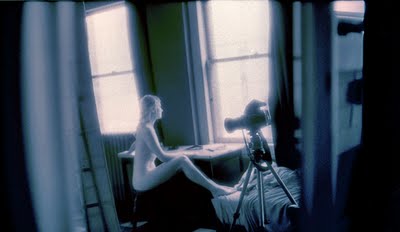
If you overexposed it a bit (or a lot) you got light going through the film and bouncing back from the pressure plate in the camera. The effect was a light halo in dark areas. The effect was and is called the halation effect. Many film manufacturers in an effort to “improve” the film started putting anti-halation layers on to their film base. Luckily Kodak never tried to do that with their infrared film of which I have about 35 rolls left in my fridge.
Kodak b+w Infrared
More Infrared
and more
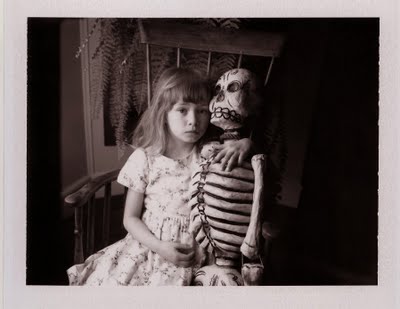
Rosemary and I worked in the garden today and I think both of us became melancholy as we saw our garden in decay. It is about this time (before all those rains come) that we change our mind about some plants and move them around. Some plants have gotten so big that they need to be divided and moved. The fall garden, after a while, looks like it’s been worked on. But the melancholy, at least for me, dissipates as I notice all the warm browns, yellows and reds of our plants, thistles and hostas. Many of the roses are full of hips this year. A few of the them surprise me with blooms here and there.
I walk into the house and I go to our busy but friendly living room and I notice Abraham Rogatnick’s life-size papier mache esqueleto (squeleton) that peacefully reposes on my psychiatric couch. We have affectionately called him Pancho and he still has the thick rope around the neck. Abraham bought Pancho in Mexico sometime in the 50s. Last year when Abraham had a premonition of his death (he died last month) he started giving some of his stuff away. I was the lucky recipient of Pancho and the rope which Abraham used to hang him from his door for Halloween. He (Pancho) is much too precious that I would ever consider hanging him outside for the forthcoming Halloween. He will be safely inside. Perhaps it was last fall that I photographed Lauren with Pancho. It was this first Polaroid (and alas, one of my last Polaroids as the Polaroid Company went the way of Packards and Studebakers, De Sotos and Oldsmobiles, not to mention Minoltas ) that I was happy with and here it is. Lauren has informed me that this year she is going to dress up as a witch for Halloween.
As for me I am literally closing one Andrea Camilleri book (all checked out from different branches of the Vancouver Public Library) to open the next. I have been keeping it at one a day. I am into the 8th tonight (The Scent of the Night). I feel that Salvo Montalbano and I are friends. I long to have him show me around his home town of Vigata right in the middle of a hot Sicilian summer. But I would starve as Montalbano loves fish and I don't. I wonder what Sicilians like for dessert?
Vigata è una cittadina immaginaria creata dallo scrittore Andrea Camilleri, in cui sono ambientate le storie del commissario Montalbano e altri romanzi dello stesso autore. La cittadina di Vigata è sita nell'altrettanto immaginaria provincia di Montelusa. Vigata è il nome immaginario di Porto Empedocle, la città natale di Camilleri.

Saturday, when we celebrated our Thanksgiving had one uniquely pleasant moment that extended for the 49 minutes of Winslow Homer – An American Original a DVD film I took out from the Vancouver Public Library. In the past we had seen a series of films on composers like Bach and Beethoven involving children so that the composers were seen as humans with human foibles. These composer series had been a success but I was not ready for the sheer beauty of this one featuring Wayne Best as Homer and the wonderful Ryan DeBoer and Tamara Hope as the two children who befriend the artist who seeks escape and quiet from hauntings of the civil way battles he sketched for Harper’s Weekly.
Rebecca knew a bit about my fondness for
Winslow Homer as I had taken her to Washington DC’s National Gallery to show her my favourite American painting, Right and Left by Homer when she was 6. I had to explain to her that Homer had sketched battle scenes but mostly scenes of soldiers waiting in their camps for Harper’s because there was yet no method for printing photographs onto magazines. The halftone process had to wait until the late 1870s and the photogravure was much too expensive, and it too was also only perfected in the 1870s.

The film inspired me to take portraits of Rebecca in the garden but I was somewhat thwarted by her contemporary T-shirt and jeans. Had we only had a dress! But Rebecca is going through a period where she hates dresses and she cries and stamps her feet when I demand she wear one. This time around I covered her with an old Scottish sweater of mine. Rebecca is sensitive to wool and complained constantly on how it made her itch. Still, she did pose for me and I was able to take a few images that pleased me. I took advantage of the situation to mention the plants in our pictures which have such nice fall colours. In particular I noted the peeling bark maple or Acer griseum that Rebecca is leaning on. The other plant is a perennial called Kirengeshoma koreana. Next spring we are going to add other plants, shrubs and trees to Rebecca's present excellent knowledge of roses and hostas.
I hope that spring brings a new aesthetic to Rebecca and she just might pose in dresses.

Sometime in 1990 we started getting phone calls from the front (the Gulf War). American soldiers were given the opportunity to call their loved ones in the US to tell them that they were alive and well. These calls came from two brothers (black they were) who had befriended my oldest daughter Ale. The first time they came to our house, we had not be warned, Ale showed up with two men who looked like Pad Doc Duvalier’s Ton-Ton Macoutes. One of them was so large that his nickname was, I believe like that of American NFL player William Perry, The Refrigerator.
Rosemary, my wife, coming from the small village of New Dublin, Ontario was shocked. I attempted to be more liberal and asked the boys to stay for dinner. The calls from the Gulf, to tell me that they were ok since I was supposed to be concerned as to their wellbeing, became suspect after a few weeks. It seems that the two boys had woven a story of truths and half-truths (when truth is simple it is far more fun to invent a more complicated reality) and Ale in the end kissed them goodbye.
It had been in 1962 when my friend Robert had noticed I did not seem to have the capacity to make female friends. “I know of a girl who has everything you would want in one. She is intelligent and artistic.” So I had a blind date with an American black woman who was a converted Jew who told me, “My name is Benjamin but you can call me Benji.” She was pretty enough but it was difficult for me to reconcile my idea of what was beautiful with a person who had wiry kinky hair and large thick ( I could not recognize their sensuousness at the time). Wherever we walked in Mexico City we were stared at. I decided to invite Benji to visit my mother in Veracruz. In Veracruz my mother used her large house to teach the children of the executives and engineers of a large Alcoa aluminum plant there. I happened to mention to my mother that my Benji was black. My mother was most liberal and accommodating but she still said, “This friend of yours would not sit well with the people who have hired me here. I suggest you do not bring her.” I remember distinctly saying to her, “If I cannot bring my friends to your house which is my home then it is no longer my home.”
The relationship ended for two reasons. Benji and I had coffee at a beatnik café in Mexico City called La Rana Sabia (the wise frog) and she told me that no woman ever had dates with a man without considering the man a potential marriageable mate. I looked at myself as she said this and decided there was too much of my life in front of me to commit to any idea of marriage. Not too long after I went to Argentina to do my military service and I kissed Benji goodbye. In Buenos Aires I received a gift subscription to Downbeat Magazine from her and then she just disappeared somewhere in Chicago.
Today we had our Thanksgiving dinner because Ale drove fom Lillooet. So we had Hilary, Rebecca and Lauren ( Hilary’s husband Bruce works until late so he could not come). Our pleasant dinner was tempered by guilt in my part.
A few days before Ale had called to tell us she was bringing a Japanese exchange student/teacher and that she would stay with us. We have an iffy arrangement with our upstairs bathrooms in that one of the tubs leaks while a toilet in the other does not work. This results in an awkward situation especially if we have guests we don’t know. Ale is welcome to stay but anybody else imposes stress on both Rosemary and I. Hilary had already figured out some musical beds in her own house and was willing to allow both Ale and her friend to stay. I simply told Ale that this was imposing on us and particularly on something as an intimate family dinner on the special occasion that is Thanksgiving.
Ale “uninvited” her friend and arrived alone for our Thanksgiving dinner. I understand that I was wrong and that a home to be a home has to always be open to our children's friends. The other side of the family-gathering-coin is our duty in putting a bit of effort to meet new people who are friendly to our daughters and to keep that line of communication alive. I fell most guilty and for the record I will try harder the next time.
Our house is not always a home. And that is tragic.
The scan you see here is that of a lowly astilbe from the garden showing off its brilliant fall colouring.

For many years I have put all my photographic eggs into the medium format basket. This means that I have taken most of my photographs with a Mamiya RB-67 with its 6x7 cm transparency or negative. Whenever I hold a 35mm camera, even that extra heavy tank that my Nikon F-3 with a motor drive is, I feel I am holding a toy. When all my printing happened strictly in the darkroom there were many negatives and transparencies that never saw the light of day. Now I like to make myself a large and strong cup of tea and look at some of my negatives wit a loupe. I am putting an extra effort into looking at pictures I took with those “small” cameras. Often the best excuse for using a 35camera (and still is) was its ability to let me shoot unburdened by a cable to a flash system. There was another excuse and that was Kodak Infrared b+w film. Alas it has been discontinued!

If you overexposed it a bit (or a lot) you got light going through the film and bouncing back from the pressure plate in the camera. The effect was a light halo in dark areas. The effect was and is called the halation effect. Many film manufacturers in an effort to “improve” the film started putting anti-halation layers on to their film base. Luckily Kodak never tried to do that with their infrared film of which I have about 35 rolls left in my fridge.
Kodak b+w Infrared
More Infrared
and more
Lauren & Pancho El Esqueleto
Monday, October 12, 2009

Rosemary and I worked in the garden today and I think both of us became melancholy as we saw our garden in decay. It is about this time (before all those rains come) that we change our mind about some plants and move them around. Some plants have gotten so big that they need to be divided and moved. The fall garden, after a while, looks like it’s been worked on. But the melancholy, at least for me, dissipates as I notice all the warm browns, yellows and reds of our plants, thistles and hostas. Many of the roses are full of hips this year. A few of the them surprise me with blooms here and there.
I walk into the house and I go to our busy but friendly living room and I notice Abraham Rogatnick’s life-size papier mache esqueleto (squeleton) that peacefully reposes on my psychiatric couch. We have affectionately called him Pancho and he still has the thick rope around the neck. Abraham bought Pancho in Mexico sometime in the 50s. Last year when Abraham had a premonition of his death (he died last month) he started giving some of his stuff away. I was the lucky recipient of Pancho and the rope which Abraham used to hang him from his door for Halloween. He (Pancho) is much too precious that I would ever consider hanging him outside for the forthcoming Halloween. He will be safely inside. Perhaps it was last fall that I photographed Lauren with Pancho. It was this first Polaroid (and alas, one of my last Polaroids as the Polaroid Company went the way of Packards and Studebakers, De Sotos and Oldsmobiles, not to mention Minoltas ) that I was happy with and here it is. Lauren has informed me that this year she is going to dress up as a witch for Halloween.
As for me I am literally closing one Andrea Camilleri book (all checked out from different branches of the Vancouver Public Library) to open the next. I have been keeping it at one a day. I am into the 8th tonight (The Scent of the Night). I feel that Salvo Montalbano and I are friends. I long to have him show me around his home town of Vigata right in the middle of a hot Sicilian summer. But I would starve as Montalbano loves fish and I don't. I wonder what Sicilians like for dessert?
Vigata è una cittadina immaginaria creata dallo scrittore Andrea Camilleri, in cui sono ambientate le storie del commissario Montalbano e altri romanzi dello stesso autore. La cittadina di Vigata è sita nell'altrettanto immaginaria provincia di Montelusa. Vigata è il nome immaginario di Porto Empedocle, la città natale di Camilleri.
Inspired By Winslow Homer
Sunday, October 11, 2009

Saturday, when we celebrated our Thanksgiving had one uniquely pleasant moment that extended for the 49 minutes of Winslow Homer – An American Original a DVD film I took out from the Vancouver Public Library. In the past we had seen a series of films on composers like Bach and Beethoven involving children so that the composers were seen as humans with human foibles. These composer series had been a success but I was not ready for the sheer beauty of this one featuring Wayne Best as Homer and the wonderful Ryan DeBoer and Tamara Hope as the two children who befriend the artist who seeks escape and quiet from hauntings of the civil way battles he sketched for Harper’s Weekly.
Rebecca knew a bit about my fondness for
Winslow Homer as I had taken her to Washington DC’s National Gallery to show her my favourite American painting, Right and Left by Homer when she was 6. I had to explain to her that Homer had sketched battle scenes but mostly scenes of soldiers waiting in their camps for Harper’s because there was yet no method for printing photographs onto magazines. The halftone process had to wait until the late 1870s and the photogravure was much too expensive, and it too was also only perfected in the 1870s.

The film inspired me to take portraits of Rebecca in the garden but I was somewhat thwarted by her contemporary T-shirt and jeans. Had we only had a dress! But Rebecca is going through a period where she hates dresses and she cries and stamps her feet when I demand she wear one. This time around I covered her with an old Scottish sweater of mine. Rebecca is sensitive to wool and complained constantly on how it made her itch. Still, she did pose for me and I was able to take a few images that pleased me. I took advantage of the situation to mention the plants in our pictures which have such nice fall colours. In particular I noted the peeling bark maple or Acer griseum that Rebecca is leaning on. The other plant is a perennial called Kirengeshoma koreana. Next spring we are going to add other plants, shrubs and trees to Rebecca's present excellent knowledge of roses and hostas.
I hope that spring brings a new aesthetic to Rebecca and she just might pose in dresses.
When A House Is Not A Home
Saturday, October 10, 2009

Sometime in 1990 we started getting phone calls from the front (the Gulf War). American soldiers were given the opportunity to call their loved ones in the US to tell them that they were alive and well. These calls came from two brothers (black they were) who had befriended my oldest daughter Ale. The first time they came to our house, we had not be warned, Ale showed up with two men who looked like Pad Doc Duvalier’s Ton-Ton Macoutes. One of them was so large that his nickname was, I believe like that of American NFL player William Perry, The Refrigerator.
Rosemary, my wife, coming from the small village of New Dublin, Ontario was shocked. I attempted to be more liberal and asked the boys to stay for dinner. The calls from the Gulf, to tell me that they were ok since I was supposed to be concerned as to their wellbeing, became suspect after a few weeks. It seems that the two boys had woven a story of truths and half-truths (when truth is simple it is far more fun to invent a more complicated reality) and Ale in the end kissed them goodbye.
It had been in 1962 when my friend Robert had noticed I did not seem to have the capacity to make female friends. “I know of a girl who has everything you would want in one. She is intelligent and artistic.” So I had a blind date with an American black woman who was a converted Jew who told me, “My name is Benjamin but you can call me Benji.” She was pretty enough but it was difficult for me to reconcile my idea of what was beautiful with a person who had wiry kinky hair and large thick ( I could not recognize their sensuousness at the time). Wherever we walked in Mexico City we were stared at. I decided to invite Benji to visit my mother in Veracruz. In Veracruz my mother used her large house to teach the children of the executives and engineers of a large Alcoa aluminum plant there. I happened to mention to my mother that my Benji was black. My mother was most liberal and accommodating but she still said, “This friend of yours would not sit well with the people who have hired me here. I suggest you do not bring her.” I remember distinctly saying to her, “If I cannot bring my friends to your house which is my home then it is no longer my home.”
The relationship ended for two reasons. Benji and I had coffee at a beatnik café in Mexico City called La Rana Sabia (the wise frog) and she told me that no woman ever had dates with a man without considering the man a potential marriageable mate. I looked at myself as she said this and decided there was too much of my life in front of me to commit to any idea of marriage. Not too long after I went to Argentina to do my military service and I kissed Benji goodbye. In Buenos Aires I received a gift subscription to Downbeat Magazine from her and then she just disappeared somewhere in Chicago.
Today we had our Thanksgiving dinner because Ale drove fom Lillooet. So we had Hilary, Rebecca and Lauren ( Hilary’s husband Bruce works until late so he could not come). Our pleasant dinner was tempered by guilt in my part.
A few days before Ale had called to tell us she was bringing a Japanese exchange student/teacher and that she would stay with us. We have an iffy arrangement with our upstairs bathrooms in that one of the tubs leaks while a toilet in the other does not work. This results in an awkward situation especially if we have guests we don’t know. Ale is welcome to stay but anybody else imposes stress on both Rosemary and I. Hilary had already figured out some musical beds in her own house and was willing to allow both Ale and her friend to stay. I simply told Ale that this was imposing on us and particularly on something as an intimate family dinner on the special occasion that is Thanksgiving.
Ale “uninvited” her friend and arrived alone for our Thanksgiving dinner. I understand that I was wrong and that a home to be a home has to always be open to our children's friends. The other side of the family-gathering-coin is our duty in putting a bit of effort to meet new people who are friendly to our daughters and to keep that line of communication alive. I fell most guilty and for the record I will try harder the next time.
Our house is not always a home. And that is tragic.
The scan you see here is that of a lowly astilbe from the garden showing off its brilliant fall colouring.
Friday, October 09, 2009
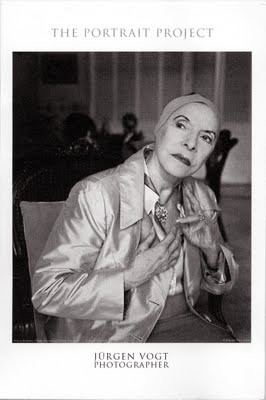
It is scary to go to an opening by a photographer who shoots b+w film and happens to just be one year older than I am.
There are other resemblances but there is one difference that makes Jürgen Vogt unique. This is his penchant and talent for calmness and patience. Calmness and patience are absolutely necessary if you are going to take portraits of venerable Canadian painters, musicians, authors, poets and prima ballerinas with a 4x5 inch view camera. Vogt eschews flash and works with available light. His average exposures are ¼ second at f-8. He shoots sparingly and might have only taken four sheets (4x5 cameras are one shot cameras and you have to load them again after each exposure) of someone like Timothy Findley, Pierre Berton or, my favourite one of them all, a portrait of singer Ian Tyson.
When Vogt traveled to Cuba (there is a fine display of Cuban photographers who photographed Guevara and Castro) he might have felt generous and taken 12 pictures instead of four.
His portraits, at the Eastwood Onley Gallery, 2075 Alberta Street, are digital prints from beautifully scanned large-format negatives. Vogt’s subjects are treated with a respect and elegance rare in this day and age.
I personally think that what he does in the age of Flickr is headed towards rapid obsolescence (redundancy in that quaint British term) and yet he maintains an easy smile on his face and there is no trace of that bitterness and anger present in so many photographers of our generation.
The most striking portrait in the room (after my fave of Ian Tyson) is of the former Cuban prima ballerina and director of the Ballet Nacional de Cuba, Alicia Alonso (her full name Alicia Ernestina de la Caridad del Cobre Martínez Hoya). Not too well known is that this dancer had an acute eye problem and for the many years that she danced she was virtually blind.
There is something Helmut Newtonish about the image, a sensuality, that makes me think that Vogt captured something of what Alonso must have been as a dancer when she was one of the best Giselles in the world.
Best of all for me was to find out that Vogt is already planning his next project.
The Portrait Project is on until October 16 and is open noon to 6pm daily.
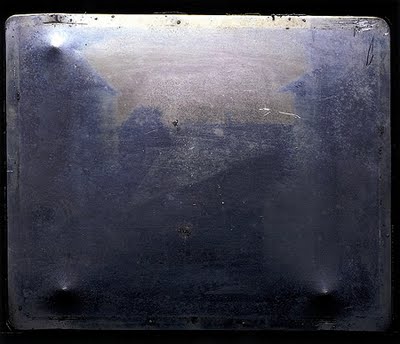
While Joseph Nicéphore Niépce came up with the first photographic process around 1825 which he called heliography, that at long last showed that nature could be captured (his view from the window at Le Gras, above)
and “fixed” so that one could study the miracle of reality, his exposures were much too slow. They were too slow to capture that fleeting reality that is man. In 1829 Niépce formed a partnership with Louis Jacques Mandé Daguerre but died in 1833. It was Daguerre who ushered in photography with his ultra sharp images on polished silver plates, the Daguerreotype, a process he announced to the world in 1839. Soon after Daguerreotype mania hit the world. Here you see a portrait of three girs taken in Berlin by Gustav Oehme in 1843.
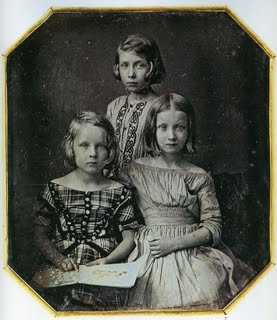
Many today believe that photography in the 19th century was black and white. Few would realize that the b+w photograph was really an invention of the 20th century and that Talbotypes (the original paper negative prints by British photographer Henry Fox Talbot) and most other prints were never black and white. To be correct we would have to call them monochrome. They came in rich earth tones or in cold blues. Some had more than one colour in what today we would define as split toning. The “modern” black and white photograph with those jet-blacks had to wait until the 20th century.
I have always been charmed by what-if? scenarios. One of my favourites is that 1990 collaboration between authors William Gibson and Bruce Sterling, The Difference Engine where real-life early computer inventor Charles Babbage’s Analytical Engine is steam driven to change permanently and irrevocably the framework of Victorian times.
In 1903 the Lumière brothers, August Marie and Louis Nicolas patented their Autochrome process which finally showed the world’s reality in a full (interestingly pointillist ) colour which dominated photography well into the 30s when the more practical and easier to use colour negative was developed.

What if Les frères Lumière had been born earlier in that century and collaborated with Niépce? It is my belief that the concept of the b+w art photograph or b+w fine art photograph would be an alien concept today. What makes a b+w print art when the same picture in colour might not be? The tradition of which one came first.


Harry Ransom Center

It is scary to go to an opening by a photographer who shoots b+w film and happens to just be one year older than I am.
There are other resemblances but there is one difference that makes Jürgen Vogt unique. This is his penchant and talent for calmness and patience. Calmness and patience are absolutely necessary if you are going to take portraits of venerable Canadian painters, musicians, authors, poets and prima ballerinas with a 4x5 inch view camera. Vogt eschews flash and works with available light. His average exposures are ¼ second at f-8. He shoots sparingly and might have only taken four sheets (4x5 cameras are one shot cameras and you have to load them again after each exposure) of someone like Timothy Findley, Pierre Berton or, my favourite one of them all, a portrait of singer Ian Tyson.
When Vogt traveled to Cuba (there is a fine display of Cuban photographers who photographed Guevara and Castro) he might have felt generous and taken 12 pictures instead of four.
His portraits, at the Eastwood Onley Gallery, 2075 Alberta Street, are digital prints from beautifully scanned large-format negatives. Vogt’s subjects are treated with a respect and elegance rare in this day and age.
I personally think that what he does in the age of Flickr is headed towards rapid obsolescence (redundancy in that quaint British term) and yet he maintains an easy smile on his face and there is no trace of that bitterness and anger present in so many photographers of our generation.
The most striking portrait in the room (after my fave of Ian Tyson) is of the former Cuban prima ballerina and director of the Ballet Nacional de Cuba, Alicia Alonso (her full name Alicia Ernestina de la Caridad del Cobre Martínez Hoya). Not too well known is that this dancer had an acute eye problem and for the many years that she danced she was virtually blind.
There is something Helmut Newtonish about the image, a sensuality, that makes me think that Vogt captured something of what Alonso must have been as a dancer when she was one of the best Giselles in the world.
Best of all for me was to find out that Vogt is already planning his next project.
The Portrait Project is on until October 16 and is open noon to 6pm daily.
What If? Those Frenchies
Thursday, October 08, 2009

While Joseph Nicéphore Niépce came up with the first photographic process around 1825 which he called heliography, that at long last showed that nature could be captured (his view from the window at Le Gras, above)
and “fixed” so that one could study the miracle of reality, his exposures were much too slow. They were too slow to capture that fleeting reality that is man. In 1829 Niépce formed a partnership with Louis Jacques Mandé Daguerre but died in 1833. It was Daguerre who ushered in photography with his ultra sharp images on polished silver plates, the Daguerreotype, a process he announced to the world in 1839. Soon after Daguerreotype mania hit the world. Here you see a portrait of three girs taken in Berlin by Gustav Oehme in 1843.

Many today believe that photography in the 19th century was black and white. Few would realize that the b+w photograph was really an invention of the 20th century and that Talbotypes (the original paper negative prints by British photographer Henry Fox Talbot) and most other prints were never black and white. To be correct we would have to call them monochrome. They came in rich earth tones or in cold blues. Some had more than one colour in what today we would define as split toning. The “modern” black and white photograph with those jet-blacks had to wait until the 20th century.
I have always been charmed by what-if? scenarios. One of my favourites is that 1990 collaboration between authors William Gibson and Bruce Sterling, The Difference Engine where real-life early computer inventor Charles Babbage’s Analytical Engine is steam driven to change permanently and irrevocably the framework of Victorian times.
In 1903 the Lumière brothers, August Marie and Louis Nicolas patented their Autochrome process which finally showed the world’s reality in a full (interestingly pointillist ) colour which dominated photography well into the 30s when the more practical and easier to use colour negative was developed.

What if Les frères Lumière had been born earlier in that century and collaborated with Niépce? It is my belief that the concept of the b+w art photograph or b+w fine art photograph would be an alien concept today. What makes a b+w print art when the same picture in colour might not be? The tradition of which one came first.


Harry Ransom Center
Wednesday, October 07, 2009
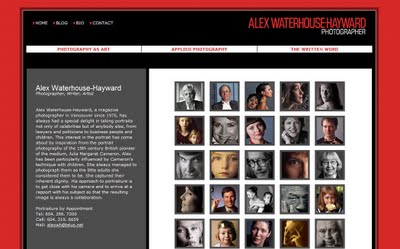
For almost four years the folks at Skunkworks including their web expert and my webmaster, Chris Botting have kept me happy with a web page and blog that works the way I want it. Every once in a while the Blogger-based blog fails but that’s another story.
As the editorial market has changed for the worst my usual markets are drying up. It is not only difficult to get a paying gig as a magazine photographer but equally as difficult to find free lance work as a writer.
I don’t think that there can ever be any profession or job that does not require some sort of support staff. I have a very good one. When I shoot my pictures my wife Rosemary is in my head telling me that little finger should be curved or that hair is in the way. She spots stuff in photographs that in the past I would not have noticed. I listen to her now even when she is not around.
Horst Wenzel keeps my cameras (old-style mechanical wonders) working and Viktor keeps my studio flashes in working order. I rely on The Lab to process my E-6 Ektachrome transparency and Grant Simmons at Disc Imaging Group drum scans my stuff when I need very good scans. He also prints my digital files as giclées. I would never print anything with a home inkjet printer.
I have a good family doctor in Doctor Colin Horricks and Doctor Simon Warner checks my eyes at least once a year.
In this day and age if you don’t know someone who is computer inclined you are dead. My friend Paul Leisz dragged me into computers some years ago and helps me install stuff in it and fixes stuff that is over my head most of the time.
But now I want to dedicate this blog to Chris Botting my web master who made my web page simple and clean (in his job as part of the Skunkworks design firm that designed this blog and webpage. Chris Botting has now installed a portal. This portal has the address www.alexwaterhousehayward.com/postcard This address is in the back of four different postcards that George Kallas at Metropolitan Fine Printers printed for me. The address takes you to portraits on a page that has been constructed to work very nicely by Chris Botting. The postcards were designed by my friend, Ian Bateson of
Baseline Type & Graphics.
Another way to get to this portal is to go from this blog to home and to click the middle dropdown menu, Applied Photography, and to select The Portrait.
The idea to create the portal with an address on the back of a postcard came from friend (about 30 years) Ray Mah of Leap Creative. He is the one who designed my identity about 30 years ago and I have never found a reason to modify it except to get rid of pager numbers and fax numbers.
In short I have survived up to know because of the above mentioned support staff.
Thank you to all.

Around 1977 I decided that my career as a photographer would soar if I started taking pictures of beautiful women and became a fashion photographer. It was not to be. I had already seen Gabriel Levy, the fashion editor for Vancouver Magazine. He had unequivocally told me I had not talent for fashion but that I might do well with portraits. I didn’t pay too much attention to him and I went around the modeling agencies in town. One of the better ones (one that did not rip off their models by telling them they had talent when they didn’t) was Morton Talent which was run by a down-to-earth and gracious Marie Morton. She looked at my photos and told me, “I think you will do for head shots of some of my models and actors. I have one piece of advice, never, I repeat never, photograph a young man wearing a puka shell necklace or earrings.”

Morton then would call me quite often to take preliminary photographs of some of her newly hired talent. Of all the pictures I ever took for her the ones that are the most memorable are photos I took of four sisters, the Samuda sisters. Two of them, Carmen and Anita Samuda were twins. One of the others (right in both pictures) was called Rita but I do not remember the name of the fourth.

In 1977 I had no concept of lighting except what was available. It was then, obviously, called available lighting! Flash of any kind was out of the question. I was into the "authentic" look. With the Samudas we went to parks, took pictures in their homes or in one case I took them in my yellow Fiat X-1/9 to Simon Fraser University. I had no studio. There are pictures here that I will not show. They would embarrass me. There is a set of photos of the sisters of the twins wearing bikinis and sitting on top of a dining room cabinet. There are pictures of the twins holding red apples (what if Eve had been a twin set?), etc. I may have unknowingly, and, in spite of everything, taken some good shots because I like the ones here.
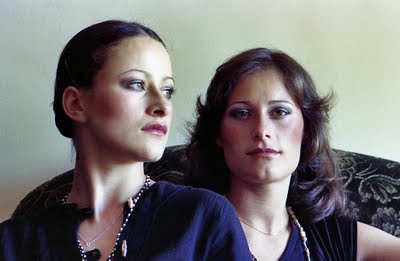
About 10 years later, in March of 1987 I proposed to Vancouver Magazine editor Mac Parry a photo story on twins. “Mac I would like to hire my family doctor, Elliot Mintz to write an essay on twins that will contain no hocus-pocus on a set of twins owning Pink Cadillacs living thousands of miles apart and separated at birth. It will be a no-nonsense article defining what twins are and how often they occur.” He gave me his blessing and I found four sets of interesting twins. The Samudas were one set.
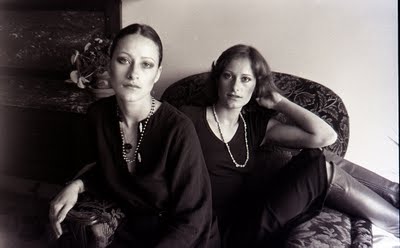
I went to the home of Carmen (I believe) who lived in Ioco. I was most surprised to find out that Carmen (then called Carmen Samuda-Lehman) had identical male twins. Carmen had always been the more outgoing one and she had these lovely buck teeth that helped to make her mouth that more sensuous and arresting. But I had a soft spot in my quickening heart for the more reserved Anita Samuda-Houlihan. There was a look in her face of sadness and tragedy that made me feel I wanted to protect her. It was a feeling I was to experience again, years later, when I met Evelyn Hart.

In 1997 I found out the four sets of twins were still in Vancouver and I suggested an encore to the editor of Vancouver Magazine. I don’t remember who he was but I thought he was an idiot (I use idiot because the word that comes to mind is not one I would write here). He told me, “We’ll pass on it.”
As I looked at the pictures today I fell in love with the Samuda sisters (all 4) all over again. I wonder where they are and what they are doing? The twin brothers would be 27 now.
I never did photograph any young men with puka shells and wearing earings.
The curious (attractive to me) colour photograph of the two sisters is the way it is because the Kodak Kodacolour negative (I shot colour negative in the late 70s) had deteriorated and shows a green/magenta shift. To make it less green it will become more magenta and vice versa. It is impossible except for those who might be Photoshop experts to "correct" the shift. Ditto with the twins and the Fiat. If I attempt to make the gray concrete less yellow/green the faces of the twins will go blue/magenta.Now that I don't have a studio I may not only take pictures on locations, but I just might opt to leave my studio lights at home.
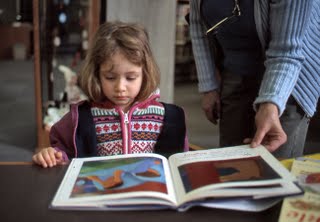
When Christopher Columbus made landfall on San Salvador ( Watlin Island) on October 12, 1492 he observed some of the inhabitants of the island breathing-in little pencil-like tubes that seemed to be on fire. The “Indians” were inhaling tobacco through their noses. While these “New World aboriginals” might have been having their nicotine hits for hundreds or perhaps thousands of years, the habit became widespread once Columbus returned with his exotic findings.
I would like to think that a habit that became “known” by the rest of the world in 1492 is on its last legs now that it is increasingly becoming difficult to even smoke out in the open in some countries and cities. There will be an end to smoking tobacco in a near future.
After reading several articles on how books are being modified to be interactive and will contain video, etc I wonder if reading as we know it will be another habit of mankind that will cease to exist in a very near future.
For years when I was living in Mexico City in the 60s and 70s some of us would laugh at the statistics of the PRI (the ruling party of the time) that gave us glowing predictions on how illiteracy was disappearing quickly. At the time buses in Mexico City were painted in certain colours and they had names like El Mariscal Sucre, Lomas Hipódromo or the extremely long blue-lined Circuito Hospitales, Cuarteles, Tlalnepantla y Anexas. The purpose of the colours and the names that could be memorized, is that many who rode these buses could not read, write or even discern the numbers of a bus. We laughingly pointed out that the statistics just proved that more people were able to read, from one year to the next, the sign on the bus. After that they did not read magazines, books or papers. They did not have the habit of reading.
If you go to an upscale Sanborns (an American style drugstore with restaurants and even more stuff than Walgreen’s) in any Mexican city you will find some of the best book selections around. Then you check the prices and notice that soft cover books go for 30 or more dollars in a peso equivalent. Reading is expensive. Comic books are far cheaper. And of course unlike our fair Vancouver and the rest of the lower mainland there are no real public libraries where you can take out a book and take it home. You have to read it in the library. Perhaps university libraries have modernized but for the average Mexican a book is a rare luxury.
If you consider what Gutenberg did for book publishing you can only wonder that nothing much has really changed in the over 500 years that have passed even if books are no longer chained to the wall.
I took my granddaughters to the main branch of the Vancouver Public Library. I have taken them before but not as much as I would like. Rebecca’s first question as we walked up the stairs was, “Who was the architect who built this? I don’t like it.” The tone was more or less set for the rest of the afternoon. We went to the Woodward Library for Youth downstairs. Both girls seemed to be lost. I have my doubts that either of them have been shown how to use a school library. I walked them around and Lauren (7) was reluctant to pull books out. Eventually Rebecca sat down to read to Lauren. This always cheers me up. When Rebecca got bored she moved by the stacks like a never ceasing hammerhead shark. I could not explain to her the wonder of the random finding of a book in a just-in section. “These books are too young for me. Let’s go somewhere else,” she told me. I showed her many books which were her level or even a bit harder but they were all “boring”. It would seem that a very young age we begin to judge books by their covers.

So we went upstairs to the teen section. But there was still no interest and the shark kept cruising with one question, “Where are the magazines?” Our day at the library ended with an open teen magazine and I became angry citing the travesty of reading a magazine one could find at London Drugs in the largest and nicest library (in spite of Moshe Safdie) in town. The final statement was, “I am reading. It is reading that is important, isn’t it?”
Reading a magazine must be a notch better than reading the name of the bus.
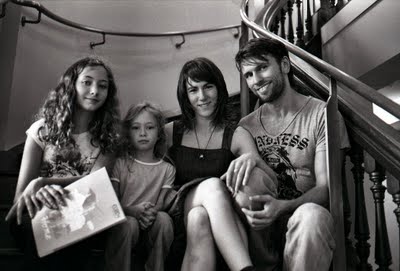
As promised in yesterday’s blog today’s is about our going to a dance performance Diary / Journal Intime at the Vancouver East Cultural Centre. Since they have recently opened the newly refurbished facilities (excellent use of the little space they always had) they are definitely promoting the use of the more affectionate moniker, the Cultch.
Rosemary, Rebecca, Lauren caught the last matinee on the last day, attendance was fair. The performance exceeded any expectations I may have had. It pleased all four of us and I saw an almost constant smile on little (7) Lauren’s face.
I asked my other granddaughter Rebecca (12) what she thought. She told me that the dance was more than dance and that the dancers were able to incorporate several languages (French, English, Spanish and some counting in German), a kind of sign language and virtuoso dancing. Rebecca noticed that the female (four) dancers had special pointe shoes that were somewhat easier to remove and put on quickly, something that the dancers did often during the performance. I couldn’t draw her out on the extreme sensuality of the show. I asked her if she thought George-Nicolas Tremblay (the male dancer in the picture here) was cute. I thought he was cute and very sexy but Rebecca played it safe with, “I am not into the dancer types. I prefer the ones in law.” I asked her about the very long kiss in the beginning of the performance between George and Roxane Duchesne-Roy, the female dancer in the photo, and her answer was noncommittal, “It was long but the afternoon was more than just sexy, it was about many other things.”
I can only guess that Rebecca would make the better and more objective dance critic. I could never be one as I could never be all that objective.
For four weeks, most recently, I visited a dying friend. Concomitantly my wife Rosemary was hit by an SUV, as a pedestrian, and suffered a severely broken ankle. I have been going with her to physiotherapy and to her doctor. I have been seeing people limping, missing limbs and watched Rosemary walk with a walker, a cane and drag herself around the garden in her attempt to help me put the garden to bed for the winter.
Seeing 7 dancers (4 females and 3 males) at their peak of their youth, doing stretches of virtuoso dancing was a treat after the hospital scene. They were attractive and had lovely bodies and moved with their inherent grace. I am not ashamed to admit to mention here that Diary/Journal Intime choreographed by Hélene Blackburn was a very sensual piece. I am not ashamed at all because my friend Artemis Gordon who runs the dance program at Arts Umbrella always stresses this fact as to why we should appreciate and love dance.
If the dance performance was not enough I have to add the original music, including standup plucking of the piano strings and (alternated with Bach solo works for piano) by pianist Matthieu Fortin.
He was playing by the time we were allowed entrance to what is now called the Historic Theatre. The young men were sitting casually on the left and the four young female dancers were sitting (casually too as they chatted with each other or adjusted their pointe shoes) on the right. I was intrigued before the performance even began. The floor was decorated with 1000 little round candles and Fortin was playing on a piano with an ancillary sound that sounded like a human being breathing deeply.
There was humour, singing, dancing, point shoe virtuosity (courtesy of Roxane Duchesne-Roy). The performance pleased us all.
Since 1995 when I first met and photographed Evelyn Hart fell in love with dance (modern, ballet, modern ballet, contact improvisational and even some of the hybrid modern/hip-hop by the likes of Amber Funk Barton and Shay Kuebler). Since Rebecca was 4 she has been accompanying me to dance. She danced at Arts Umbrella until recently and gave up dance to hunker down on her scholastic life (I do not agree with this but then I am only the grandfather). Rebecca knows about dance and she told me as we watched the performance of Diary/Journal Intime yesterday, “Only Roxane can really dance some of those difficult parts. The only other one would be the girl with the ponytail. I am not all that sure that I could be that objective but I think I would agree. The girl in the pony tail was Susan Paulson. At one point Paulson let her hairs loose and was transformed for me. Suddenly her virtuosity seemed to match Duchesne-Roy’s. My Rebecca was right.
We left for home contented and happy.
I wasn’t all that happy. I know that the Straight gave a glowing mention/preview but I am not aware of any media attention to what certainly one of the most memorable dance performances for a while. Sometimes no matter how good our own home-grown dance scene is I believe we need to see what other countries or at least other provinces in Canada are doing with dance. This performance merited a review, a glowing review early on.

Arts organizations in Vancouver including the Cultch, run by Heather Redfern, right, cannot run them on grants and declining government funding. They need to fill seats. A couple of good reviews (certainly Diary/Journal Intime , a Cas Public Production deserved them) would have put more people in more seats. Then the show can go on.
It is for this reason that I believe that our city needs what I call a Vancouver Arts Web Hub. This would be a web page containing a central hub (a de facto web arts magazine) run by a paid editor who would hire competent writers to write intelligent reviews, but more important, intelligent previews that would attract the presence of more paying customers to dance, theatre, music, opera and visual arts performances and shows. This web hub would also have links to all the web pages of participating arts organizations like the VSO, the Vancouver Opera, Arts Club Theatre, Ballet BC and many of the much smaller institutions with small advertising budgets.
If many people paid and went to see Diary/ Journal Intime, then I am happy for them and for Heather Redfern’s Cultch. If this was not the case then it is a travesty that has to be soon corrected. I believe that steps are being taken in that direction.
Cas Public
the dancers

This afternoon Rosemary, the girls and I went to the Vancouver East Cultural Centre to a wonderful performance of dance from Montreal, Diary/Journal Intime. I will write about it tomorrow as I have not had the time this evening to process the roll of Kodak Plus-X with which I took a few pictures of two of the dancers with Rebecca and Lauren.
Time went quickly as I had to cook a roast beef for dinner and Rosemary made her “famous in our family” Yorkshire Pudding. We served the roast with potatoes, carrots and onions with lightly steamed snow peas on the side. Rebecca had several helpings of my meat gravy. Then I heard a scream in the kitchen when she cleared the table. It seems she spotted some blood on the cutting board which had oozed out from what was left of the roast. I explained to her that I had poured most of it into the gravy and that is why it was good. These Saturday night family dinners (and sometimes on Monday nights as well as Thanksgiving and Christmas Eve) are really a way for me to go back to the family dinners of my past especially the ones that were held at my Auntie Winnie's who was married to my father's oldest brother Harry. I remember Uncle Harry putting sugar into his mixture of Colman's Mustard for the salad he prepared. I remember Auntie Winnies severely deformed hands as she poured us her tea which we wolfed down with her lovely scones. To repeat that so beautiful statement from the Last Supper, "Do this in memory of me."
We listened to some Gerry Mulligan and eventually all the girls, Rosemary, Lauren, Rebecca and Hilary ended up on our bed with Toby the cat while I scanned what you see here. Tonight may have been the last Saturday where I will be able to cut fresh roses from the garden to put on the dinner table. There were a few but the one that caught my eye was Rosa ‘Brother Cadfael’. I read all of the Brother Cadfael novels written by Ellis Peters. There is one that sticks out in my memory called Monkshood. The botanical name for this extremely poisonous perennial is aconitum. The variety that was growing not far from Brother Cadfael was Aconitum carmichaelii 'Arendsii'. Rosemary has a fondness for this plant’s very blue flowers and this very tall (7ft) variety flowers in the fall. Both Rebecca and Lauren know about the poisonous nature of this plant as well as Brother Cadfael. In the novel called Monkshood you do not have to guess what the murderer uses to do away with his victim.
Me gustan todas, me gustan todas,
me gustan todas en general,
pero esa rubia, pero esa rubia,
pero esa rubia me gusta más.
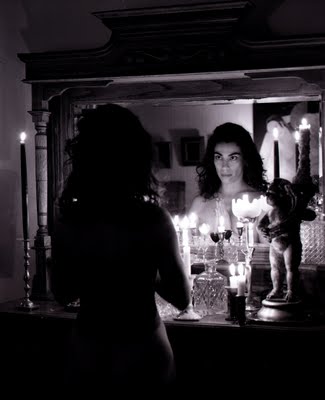
I like them all, I like them all
I like them all generally
but that blonde, but that blonde
I really like most of all.
Chiquillo, no digas eso,
que tu madre te va a pegar.
Mi madre a mí no me pega
Cuando digo la verdad.
Ta-ra-la-la, Ta-ra-la-la, Ta-ra-la-la....
Pero esa rubia, pero esa rubia,
pero esa rubia me gusta más.
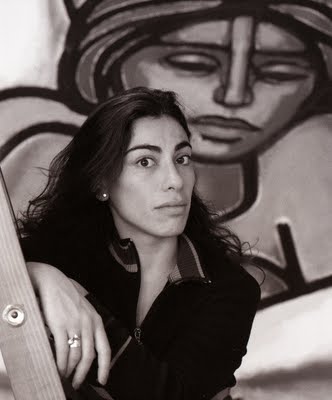
Little boy, don't say that,
or your mother is going to spank you.
My mother does not spank me
when I tell the truth.
Ta-ra-la-la, Ta-ra-la-la, Ta-ra-la-la....
But that blonde, but that blonde
I like most of all.
Since I could remember my grandmother would sing the above song on how men like all women but specially when they are blondes. I have no idea what would have made her sing it (the tune was a catchy one) in my presence. The only blondes in my family at the time were all relatives from my father's side.
In 1968 when this half-Latin gazed at the blond hair of my soon-to-be wife, noticed her lovely face, her wonderful blue eyes and her most shapely legs (as shapely as my mother's and she had the best legs in the world) I fell for her. Before I knew it I was married to Rosemary, a spectacular blonde. This is an action I have never regretted and I would do it again, over and over.
But every now and then I will see a dark-haired woman, particularly Latinas like the Chilean-born Carmen Aguirre in the pictures here and feel a longing from what seems to be in my innermost being. It is a nostalgia for my Latin roots. This longing is there even though Latins, and particularly Mexican men (I lived in Mexico for many years) will lose all their cognative ability when they see a blonde.
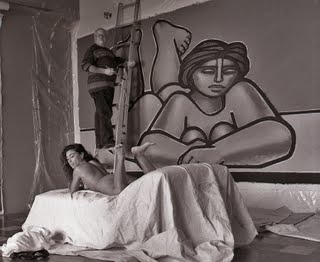
Juan Manuel Sanchez the man painting the mural on the big canvas hanging in my studio a few years, ago would have probably asserted, "Solo una morocha es una verdadera mujer." (Only a dark-haired woman is a real woman.)
Whichever way you want to look at this, I wish I could leave you with the tune that is now playing in my head in the voice of my grandmother's colaratura. She had a delightful smile on her face as she sang it "con sal" (with feeling and humour). Perhaps she was looking into my future.
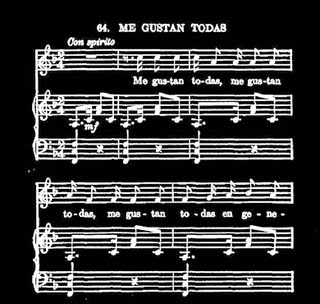
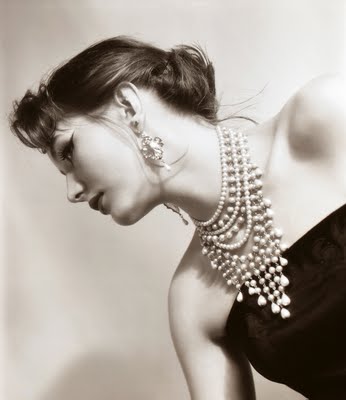
Today I visited myself.
My ex student Gabriel Beltrán, he graduated from Van Arts where I teach photography, came for a visit. He is returning to his home in Monterrey, Mexico next week. He must be close to 30 years old. After our homemade pizza lunch, washed down with a blender pineapple drink, we sat down in the living room to sip some strong Kenyan Kambaa tea. Gabriel rifled through my photography book collection putting a particular emphasis on the ones that contain nudes. I decided to put some music. The first CD I played was Stan Getz and Kenny Barron People Time (the last recording by Getz). I played my favourite track, First Song (For Ruth) by Charlie Haden. With a pen in hand an a sheet of paper Gabriel asked, “Who's that?” I replied, “Stan Getz.” “How do you spell that?” he enquired.
That second question transported me to Mexico City College in 1962. It was there that my friend Robert Hijar said to me, “Have you heard this?” Somehow he pointed at a radio that was playing, perhaps in the college cafeteria. I don’t remember, exactly. I then listened to some of the most startling, fresh and beautiful music I had ever heard in my life. It was Stan Getz and Charlie Byrd playing Desafinado from the just released album Jazz Samba.

It would seem that in a smaller way, Gabriel first heard Stan Getz today.
From Getz we went to Charlie Haden’s Quartet West – In Angel City to listen to Haden’s own version of that First Son (For Ruth). I went to my book case and took out a couple of Raymond Chandlers and told Gabriel, “This Charlie Haden album is really inspired by the works of this writer. Humphrey Bogart played his hero in a wonderful film noir.”
From Chandler we then listened to the Dave Brubeck Quartet, Jazz Impressions of Eurasia. Again that question as to who it was and how did you spell Brubeck. Then it was Oscar Peterson and Milt Jackson playing the Work Song, Dizzy Gillespie playing Con Alma, Daniel Barenboim’s Mi Buenos Aires Querido and we sort of finished with an early Astor Piazzolla Octet CD. Sort of finished because I could not find Aaron Copland’s Salón Mexico I my CD collection so I went to the computer and found it on YouTube. I had told Gabriel that the American Aaron Copland (1900-1990) is my favourite Mexican composer. I will stick to his opinion as he sounded more like the Mexican Silvestre Revueltas (1899-1940) before (or simply better) that famous composer composed his own works.
Suddenly I was to answer the question as to who was my fovourite photographer. I mentioned Philippe Halsman. He had forgotten the name but not my book or the pictures in it as I had taken it to school and he had perused it during one of the class breaks. I then handed him Halsman at Work by Philipp Halsman and Yvonne Halsman. This book shows how Halsman took some of his most famous photograph all intimately explained by Halsman’s wife. Included here are the incredible ones of Dalí in the air with all those cats and buckets of water. Suddenly Gabriel had found a book that interested him more than all the ones about nudes. “It’s like being behind the photographer during the shooting session,”he said to me. All I could add to that was, “Unless you know that the book exists because you have it your hand now you would never in our present times now about it.”
It seems we ran out of time and I never was able to answer his question, “Can you recommend me some poets?” Right off the bat it would have been Cuban Nicolás Guillén and Mexican Homero Aridjis.
I had to go to town so I drove Gabriel. In the car’s CD player we listened to Duke Ellington playing Oclupaca (Acapulco backwards) and Tina (dedicated to Argentina).
It would seem that the much younger Gabriel is experiencing for the first time (alas that is something that few my age can do) the delights of Getz, Chandler, Ellington and Brubeck. It was me all over again.
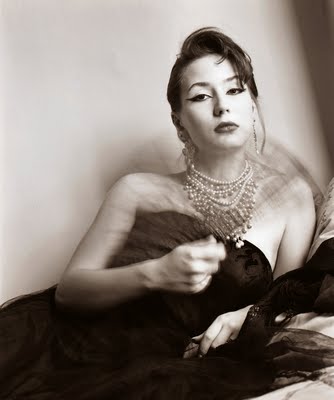
But it wasn’t all one sided. As he leafed through the Halsman book I noticed how many of Halsman’s pictures had not been taken in a studio. I looked around my living room. It is a nice one with books, pictures on the wall and that psychiatric couch. I don’t have a studio anymore. Could this be a new and exciting beginning (continuation)? Could it be that I will experience something for the first time(again)?
I would have never given the pictures I took of Daniella Ciccone some 18 years ago a second look. Today I did. Not bad for pictures taken in her house!

For almost four years the folks at Skunkworks including their web expert and my webmaster, Chris Botting have kept me happy with a web page and blog that works the way I want it. Every once in a while the Blogger-based blog fails but that’s another story.
As the editorial market has changed for the worst my usual markets are drying up. It is not only difficult to get a paying gig as a magazine photographer but equally as difficult to find free lance work as a writer.
I don’t think that there can ever be any profession or job that does not require some sort of support staff. I have a very good one. When I shoot my pictures my wife Rosemary is in my head telling me that little finger should be curved or that hair is in the way. She spots stuff in photographs that in the past I would not have noticed. I listen to her now even when she is not around.
Horst Wenzel keeps my cameras (old-style mechanical wonders) working and Viktor keeps my studio flashes in working order. I rely on The Lab to process my E-6 Ektachrome transparency and Grant Simmons at Disc Imaging Group drum scans my stuff when I need very good scans. He also prints my digital files as giclées. I would never print anything with a home inkjet printer.
I have a good family doctor in Doctor Colin Horricks and Doctor Simon Warner checks my eyes at least once a year.
In this day and age if you don’t know someone who is computer inclined you are dead. My friend Paul Leisz dragged me into computers some years ago and helps me install stuff in it and fixes stuff that is over my head most of the time.
But now I want to dedicate this blog to Chris Botting my web master who made my web page simple and clean (in his job as part of the Skunkworks design firm that designed this blog and webpage. Chris Botting has now installed a portal. This portal has the address www.alexwaterhousehayward.com/postcard This address is in the back of four different postcards that George Kallas at Metropolitan Fine Printers printed for me. The address takes you to portraits on a page that has been constructed to work very nicely by Chris Botting. The postcards were designed by my friend, Ian Bateson of
Baseline Type & Graphics.
Another way to get to this portal is to go from this blog to home and to click the middle dropdown menu, Applied Photography, and to select The Portrait.
The idea to create the portal with an address on the back of a postcard came from friend (about 30 years) Ray Mah of Leap Creative. He is the one who designed my identity about 30 years ago and I have never found a reason to modify it except to get rid of pager numbers and fax numbers.
In short I have survived up to know because of the above mentioned support staff.
Thank you to all.
Twins, Sisters, Puka Shells & A Yellow Fiat X-1/9
Tuesday, October 06, 2009

Around 1977 I decided that my career as a photographer would soar if I started taking pictures of beautiful women and became a fashion photographer. It was not to be. I had already seen Gabriel Levy, the fashion editor for Vancouver Magazine. He had unequivocally told me I had not talent for fashion but that I might do well with portraits. I didn’t pay too much attention to him and I went around the modeling agencies in town. One of the better ones (one that did not rip off their models by telling them they had talent when they didn’t) was Morton Talent which was run by a down-to-earth and gracious Marie Morton. She looked at my photos and told me, “I think you will do for head shots of some of my models and actors. I have one piece of advice, never, I repeat never, photograph a young man wearing a puka shell necklace or earrings.”

Morton then would call me quite often to take preliminary photographs of some of her newly hired talent. Of all the pictures I ever took for her the ones that are the most memorable are photos I took of four sisters, the Samuda sisters. Two of them, Carmen and Anita Samuda were twins. One of the others (right in both pictures) was called Rita but I do not remember the name of the fourth.

In 1977 I had no concept of lighting except what was available. It was then, obviously, called available lighting! Flash of any kind was out of the question. I was into the "authentic" look. With the Samudas we went to parks, took pictures in their homes or in one case I took them in my yellow Fiat X-1/9 to Simon Fraser University. I had no studio. There are pictures here that I will not show. They would embarrass me. There is a set of photos of the sisters of the twins wearing bikinis and sitting on top of a dining room cabinet. There are pictures of the twins holding red apples (what if Eve had been a twin set?), etc. I may have unknowingly, and, in spite of everything, taken some good shots because I like the ones here.

About 10 years later, in March of 1987 I proposed to Vancouver Magazine editor Mac Parry a photo story on twins. “Mac I would like to hire my family doctor, Elliot Mintz to write an essay on twins that will contain no hocus-pocus on a set of twins owning Pink Cadillacs living thousands of miles apart and separated at birth. It will be a no-nonsense article defining what twins are and how often they occur.” He gave me his blessing and I found four sets of interesting twins. The Samudas were one set.

I went to the home of Carmen (I believe) who lived in Ioco. I was most surprised to find out that Carmen (then called Carmen Samuda-Lehman) had identical male twins. Carmen had always been the more outgoing one and she had these lovely buck teeth that helped to make her mouth that more sensuous and arresting. But I had a soft spot in my quickening heart for the more reserved Anita Samuda-Houlihan. There was a look in her face of sadness and tragedy that made me feel I wanted to protect her. It was a feeling I was to experience again, years later, when I met Evelyn Hart.

In 1997 I found out the four sets of twins were still in Vancouver and I suggested an encore to the editor of Vancouver Magazine. I don’t remember who he was but I thought he was an idiot (I use idiot because the word that comes to mind is not one I would write here). He told me, “We’ll pass on it.”
As I looked at the pictures today I fell in love with the Samuda sisters (all 4) all over again. I wonder where they are and what they are doing? The twin brothers would be 27 now.
I never did photograph any young men with puka shells and wearing earings.
The curious (attractive to me) colour photograph of the two sisters is the way it is because the Kodak Kodacolour negative (I shot colour negative in the late 70s) had deteriorated and shows a green/magenta shift. To make it less green it will become more magenta and vice versa. It is impossible except for those who might be Photoshop experts to "correct" the shift. Ditto with the twins and the Fiat. If I attempt to make the gray concrete less yellow/green the faces of the twins will go blue/magenta.Now that I don't have a studio I may not only take pictures on locations, but I just might opt to leave my studio lights at home.
Reading Takes A Holiday
Monday, October 05, 2009

When Christopher Columbus made landfall on San Salvador ( Watlin Island) on October 12, 1492 he observed some of the inhabitants of the island breathing-in little pencil-like tubes that seemed to be on fire. The “Indians” were inhaling tobacco through their noses. While these “New World aboriginals” might have been having their nicotine hits for hundreds or perhaps thousands of years, the habit became widespread once Columbus returned with his exotic findings.
I would like to think that a habit that became “known” by the rest of the world in 1492 is on its last legs now that it is increasingly becoming difficult to even smoke out in the open in some countries and cities. There will be an end to smoking tobacco in a near future.
After reading several articles on how books are being modified to be interactive and will contain video, etc I wonder if reading as we know it will be another habit of mankind that will cease to exist in a very near future.
For years when I was living in Mexico City in the 60s and 70s some of us would laugh at the statistics of the PRI (the ruling party of the time) that gave us glowing predictions on how illiteracy was disappearing quickly. At the time buses in Mexico City were painted in certain colours and they had names like El Mariscal Sucre, Lomas Hipódromo or the extremely long blue-lined Circuito Hospitales, Cuarteles, Tlalnepantla y Anexas. The purpose of the colours and the names that could be memorized, is that many who rode these buses could not read, write or even discern the numbers of a bus. We laughingly pointed out that the statistics just proved that more people were able to read, from one year to the next, the sign on the bus. After that they did not read magazines, books or papers. They did not have the habit of reading.
If you go to an upscale Sanborns (an American style drugstore with restaurants and even more stuff than Walgreen’s) in any Mexican city you will find some of the best book selections around. Then you check the prices and notice that soft cover books go for 30 or more dollars in a peso equivalent. Reading is expensive. Comic books are far cheaper. And of course unlike our fair Vancouver and the rest of the lower mainland there are no real public libraries where you can take out a book and take it home. You have to read it in the library. Perhaps university libraries have modernized but for the average Mexican a book is a rare luxury.
If you consider what Gutenberg did for book publishing you can only wonder that nothing much has really changed in the over 500 years that have passed even if books are no longer chained to the wall.
I took my granddaughters to the main branch of the Vancouver Public Library. I have taken them before but not as much as I would like. Rebecca’s first question as we walked up the stairs was, “Who was the architect who built this? I don’t like it.” The tone was more or less set for the rest of the afternoon. We went to the Woodward Library for Youth downstairs. Both girls seemed to be lost. I have my doubts that either of them have been shown how to use a school library. I walked them around and Lauren (7) was reluctant to pull books out. Eventually Rebecca sat down to read to Lauren. This always cheers me up. When Rebecca got bored she moved by the stacks like a never ceasing hammerhead shark. I could not explain to her the wonder of the random finding of a book in a just-in section. “These books are too young for me. Let’s go somewhere else,” she told me. I showed her many books which were her level or even a bit harder but they were all “boring”. It would seem that a very young age we begin to judge books by their covers.

So we went upstairs to the teen section. But there was still no interest and the shark kept cruising with one question, “Where are the magazines?” Our day at the library ended with an open teen magazine and I became angry citing the travesty of reading a magazine one could find at London Drugs in the largest and nicest library (in spite of Moshe Safdie) in town. The final statement was, “I am reading. It is reading that is important, isn’t it?”
Reading a magazine must be a notch better than reading the name of the bus.
Diary/Journal Intime
Sunday, October 04, 2009

As promised in yesterday’s blog today’s is about our going to a dance performance Diary / Journal Intime at the Vancouver East Cultural Centre. Since they have recently opened the newly refurbished facilities (excellent use of the little space they always had) they are definitely promoting the use of the more affectionate moniker, the Cultch.
Rosemary, Rebecca, Lauren caught the last matinee on the last day, attendance was fair. The performance exceeded any expectations I may have had. It pleased all four of us and I saw an almost constant smile on little (7) Lauren’s face.
I asked my other granddaughter Rebecca (12) what she thought. She told me that the dance was more than dance and that the dancers were able to incorporate several languages (French, English, Spanish and some counting in German), a kind of sign language and virtuoso dancing. Rebecca noticed that the female (four) dancers had special pointe shoes that were somewhat easier to remove and put on quickly, something that the dancers did often during the performance. I couldn’t draw her out on the extreme sensuality of the show. I asked her if she thought George-Nicolas Tremblay (the male dancer in the picture here) was cute. I thought he was cute and very sexy but Rebecca played it safe with, “I am not into the dancer types. I prefer the ones in law.” I asked her about the very long kiss in the beginning of the performance between George and Roxane Duchesne-Roy, the female dancer in the photo, and her answer was noncommittal, “It was long but the afternoon was more than just sexy, it was about many other things.”
I can only guess that Rebecca would make the better and more objective dance critic. I could never be one as I could never be all that objective.
For four weeks, most recently, I visited a dying friend. Concomitantly my wife Rosemary was hit by an SUV, as a pedestrian, and suffered a severely broken ankle. I have been going with her to physiotherapy and to her doctor. I have been seeing people limping, missing limbs and watched Rosemary walk with a walker, a cane and drag herself around the garden in her attempt to help me put the garden to bed for the winter.
Seeing 7 dancers (4 females and 3 males) at their peak of their youth, doing stretches of virtuoso dancing was a treat after the hospital scene. They were attractive and had lovely bodies and moved with their inherent grace. I am not ashamed to admit to mention here that Diary/Journal Intime choreographed by Hélene Blackburn was a very sensual piece. I am not ashamed at all because my friend Artemis Gordon who runs the dance program at Arts Umbrella always stresses this fact as to why we should appreciate and love dance.
If the dance performance was not enough I have to add the original music, including standup plucking of the piano strings and (alternated with Bach solo works for piano) by pianist Matthieu Fortin.
He was playing by the time we were allowed entrance to what is now called the Historic Theatre. The young men were sitting casually on the left and the four young female dancers were sitting (casually too as they chatted with each other or adjusted their pointe shoes) on the right. I was intrigued before the performance even began. The floor was decorated with 1000 little round candles and Fortin was playing on a piano with an ancillary sound that sounded like a human being breathing deeply.
There was humour, singing, dancing, point shoe virtuosity (courtesy of Roxane Duchesne-Roy). The performance pleased us all.
Since 1995 when I first met and photographed Evelyn Hart fell in love with dance (modern, ballet, modern ballet, contact improvisational and even some of the hybrid modern/hip-hop by the likes of Amber Funk Barton and Shay Kuebler). Since Rebecca was 4 she has been accompanying me to dance. She danced at Arts Umbrella until recently and gave up dance to hunker down on her scholastic life (I do not agree with this but then I am only the grandfather). Rebecca knows about dance and she told me as we watched the performance of Diary/Journal Intime yesterday, “Only Roxane can really dance some of those difficult parts. The only other one would be the girl with the ponytail. I am not all that sure that I could be that objective but I think I would agree. The girl in the pony tail was Susan Paulson. At one point Paulson let her hairs loose and was transformed for me. Suddenly her virtuosity seemed to match Duchesne-Roy’s. My Rebecca was right.
We left for home contented and happy.
I wasn’t all that happy. I know that the Straight gave a glowing mention/preview but I am not aware of any media attention to what certainly one of the most memorable dance performances for a while. Sometimes no matter how good our own home-grown dance scene is I believe we need to see what other countries or at least other provinces in Canada are doing with dance. This performance merited a review, a glowing review early on.

Arts organizations in Vancouver including the Cultch, run by Heather Redfern, right, cannot run them on grants and declining government funding. They need to fill seats. A couple of good reviews (certainly Diary/Journal Intime , a Cas Public Production deserved them) would have put more people in more seats. Then the show can go on.
It is for this reason that I believe that our city needs what I call a Vancouver Arts Web Hub. This would be a web page containing a central hub (a de facto web arts magazine) run by a paid editor who would hire competent writers to write intelligent reviews, but more important, intelligent previews that would attract the presence of more paying customers to dance, theatre, music, opera and visual arts performances and shows. This web hub would also have links to all the web pages of participating arts organizations like the VSO, the Vancouver Opera, Arts Club Theatre, Ballet BC and many of the much smaller institutions with small advertising budgets.
If many people paid and went to see Diary/ Journal Intime, then I am happy for them and for Heather Redfern’s Cultch. If this was not the case then it is a travesty that has to be soon corrected. I believe that steps are being taken in that direction.
Cas Public
the dancers
Brother Cadfael's Monkshood
Saturday, October 03, 2009

This afternoon Rosemary, the girls and I went to the Vancouver East Cultural Centre to a wonderful performance of dance from Montreal, Diary/Journal Intime. I will write about it tomorrow as I have not had the time this evening to process the roll of Kodak Plus-X with which I took a few pictures of two of the dancers with Rebecca and Lauren.
Time went quickly as I had to cook a roast beef for dinner and Rosemary made her “famous in our family” Yorkshire Pudding. We served the roast with potatoes, carrots and onions with lightly steamed snow peas on the side. Rebecca had several helpings of my meat gravy. Then I heard a scream in the kitchen when she cleared the table. It seems she spotted some blood on the cutting board which had oozed out from what was left of the roast. I explained to her that I had poured most of it into the gravy and that is why it was good. These Saturday night family dinners (and sometimes on Monday nights as well as Thanksgiving and Christmas Eve) are really a way for me to go back to the family dinners of my past especially the ones that were held at my Auntie Winnie's who was married to my father's oldest brother Harry. I remember Uncle Harry putting sugar into his mixture of Colman's Mustard for the salad he prepared. I remember Auntie Winnies severely deformed hands as she poured us her tea which we wolfed down with her lovely scones. To repeat that so beautiful statement from the Last Supper, "Do this in memory of me."
We listened to some Gerry Mulligan and eventually all the girls, Rosemary, Lauren, Rebecca and Hilary ended up on our bed with Toby the cat while I scanned what you see here. Tonight may have been the last Saturday where I will be able to cut fresh roses from the garden to put on the dinner table. There were a few but the one that caught my eye was Rosa ‘Brother Cadfael’. I read all of the Brother Cadfael novels written by Ellis Peters. There is one that sticks out in my memory called Monkshood. The botanical name for this extremely poisonous perennial is aconitum. The variety that was growing not far from Brother Cadfael was Aconitum carmichaelii 'Arendsii'. Rosemary has a fondness for this plant’s very blue flowers and this very tall (7ft) variety flowers in the fall. Both Rebecca and Lauren know about the poisonous nature of this plant as well as Brother Cadfael. In the novel called Monkshood you do not have to guess what the murderer uses to do away with his victim.
Me Gustan Todas, Me Gustan Todas, Pero Esa Rubia...
Friday, October 02, 2009
Me gustan todas, me gustan todas,
me gustan todas en general,
pero esa rubia, pero esa rubia,
pero esa rubia me gusta más.

I like them all, I like them all
I like them all generally
but that blonde, but that blonde
I really like most of all.
Chiquillo, no digas eso,
que tu madre te va a pegar.
Mi madre a mí no me pega
Cuando digo la verdad.
Ta-ra-la-la, Ta-ra-la-la, Ta-ra-la-la....
Pero esa rubia, pero esa rubia,
pero esa rubia me gusta más.

Little boy, don't say that,
or your mother is going to spank you.
My mother does not spank me
when I tell the truth.
Ta-ra-la-la, Ta-ra-la-la, Ta-ra-la-la....
But that blonde, but that blonde
I like most of all.
Since I could remember my grandmother would sing the above song on how men like all women but specially when they are blondes. I have no idea what would have made her sing it (the tune was a catchy one) in my presence. The only blondes in my family at the time were all relatives from my father's side.
In 1968 when this half-Latin gazed at the blond hair of my soon-to-be wife, noticed her lovely face, her wonderful blue eyes and her most shapely legs (as shapely as my mother's and she had the best legs in the world) I fell for her. Before I knew it I was married to Rosemary, a spectacular blonde. This is an action I have never regretted and I would do it again, over and over.
But every now and then I will see a dark-haired woman, particularly Latinas like the Chilean-born Carmen Aguirre in the pictures here and feel a longing from what seems to be in my innermost being. It is a nostalgia for my Latin roots. This longing is there even though Latins, and particularly Mexican men (I lived in Mexico for many years) will lose all their cognative ability when they see a blonde.

Juan Manuel Sanchez the man painting the mural on the big canvas hanging in my studio a few years, ago would have probably asserted, "Solo una morocha es una verdadera mujer." (Only a dark-haired woman is a real woman.)
Whichever way you want to look at this, I wish I could leave you with the tune that is now playing in my head in the voice of my grandmother's colaratura. She had a delightful smile on her face as she sang it "con sal" (with feeling and humour). Perhaps she was looking into my future.

I Visit Myself
Thursday, October 01, 2009

Today I visited myself.
My ex student Gabriel Beltrán, he graduated from Van Arts where I teach photography, came for a visit. He is returning to his home in Monterrey, Mexico next week. He must be close to 30 years old. After our homemade pizza lunch, washed down with a blender pineapple drink, we sat down in the living room to sip some strong Kenyan Kambaa tea. Gabriel rifled through my photography book collection putting a particular emphasis on the ones that contain nudes. I decided to put some music. The first CD I played was Stan Getz and Kenny Barron People Time (the last recording by Getz). I played my favourite track, First Song (For Ruth) by Charlie Haden. With a pen in hand an a sheet of paper Gabriel asked, “Who's that?” I replied, “Stan Getz.” “How do you spell that?” he enquired.
That second question transported me to Mexico City College in 1962. It was there that my friend Robert Hijar said to me, “Have you heard this?” Somehow he pointed at a radio that was playing, perhaps in the college cafeteria. I don’t remember, exactly. I then listened to some of the most startling, fresh and beautiful music I had ever heard in my life. It was Stan Getz and Charlie Byrd playing Desafinado from the just released album Jazz Samba.

It would seem that in a smaller way, Gabriel first heard Stan Getz today.
From Getz we went to Charlie Haden’s Quartet West – In Angel City to listen to Haden’s own version of that First Son (For Ruth). I went to my book case and took out a couple of Raymond Chandlers and told Gabriel, “This Charlie Haden album is really inspired by the works of this writer. Humphrey Bogart played his hero in a wonderful film noir.”
From Chandler we then listened to the Dave Brubeck Quartet, Jazz Impressions of Eurasia. Again that question as to who it was and how did you spell Brubeck. Then it was Oscar Peterson and Milt Jackson playing the Work Song, Dizzy Gillespie playing Con Alma, Daniel Barenboim’s Mi Buenos Aires Querido and we sort of finished with an early Astor Piazzolla Octet CD. Sort of finished because I could not find Aaron Copland’s Salón Mexico I my CD collection so I went to the computer and found it on YouTube. I had told Gabriel that the American Aaron Copland (1900-1990) is my favourite Mexican composer. I will stick to his opinion as he sounded more like the Mexican Silvestre Revueltas (1899-1940) before (or simply better) that famous composer composed his own works.
Suddenly I was to answer the question as to who was my fovourite photographer. I mentioned Philippe Halsman. He had forgotten the name but not my book or the pictures in it as I had taken it to school and he had perused it during one of the class breaks. I then handed him Halsman at Work by Philipp Halsman and Yvonne Halsman. This book shows how Halsman took some of his most famous photograph all intimately explained by Halsman’s wife. Included here are the incredible ones of Dalí in the air with all those cats and buckets of water. Suddenly Gabriel had found a book that interested him more than all the ones about nudes. “It’s like being behind the photographer during the shooting session,”he said to me. All I could add to that was, “Unless you know that the book exists because you have it your hand now you would never in our present times now about it.”
It seems we ran out of time and I never was able to answer his question, “Can you recommend me some poets?” Right off the bat it would have been Cuban Nicolás Guillén and Mexican Homero Aridjis.
I had to go to town so I drove Gabriel. In the car’s CD player we listened to Duke Ellington playing Oclupaca (Acapulco backwards) and Tina (dedicated to Argentina).
It would seem that the much younger Gabriel is experiencing for the first time (alas that is something that few my age can do) the delights of Getz, Chandler, Ellington and Brubeck. It was me all over again.

But it wasn’t all one sided. As he leafed through the Halsman book I noticed how many of Halsman’s pictures had not been taken in a studio. I looked around my living room. It is a nice one with books, pictures on the wall and that psychiatric couch. I don’t have a studio anymore. Could this be a new and exciting beginning (continuation)? Could it be that I will experience something for the first time(again)?
I would have never given the pictures I took of Daniella Ciccone some 18 years ago a second look. Today I did. Not bad for pictures taken in her house!






